Étiquette : Mesopotamia
Posted by: Karel Vereycken | on janvier 20, 2024
The science of Oases, from the Indus Valley to Persian qanats

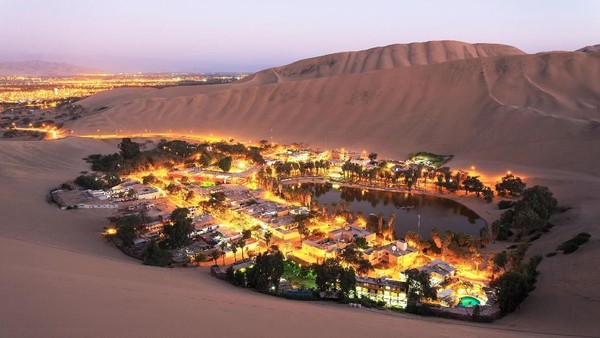
Presentation of Karel Vereycken at the first panel discussion of the « Water for Peace » seminar organized by the Schiller Institute on January 9, 2024 in Paris.
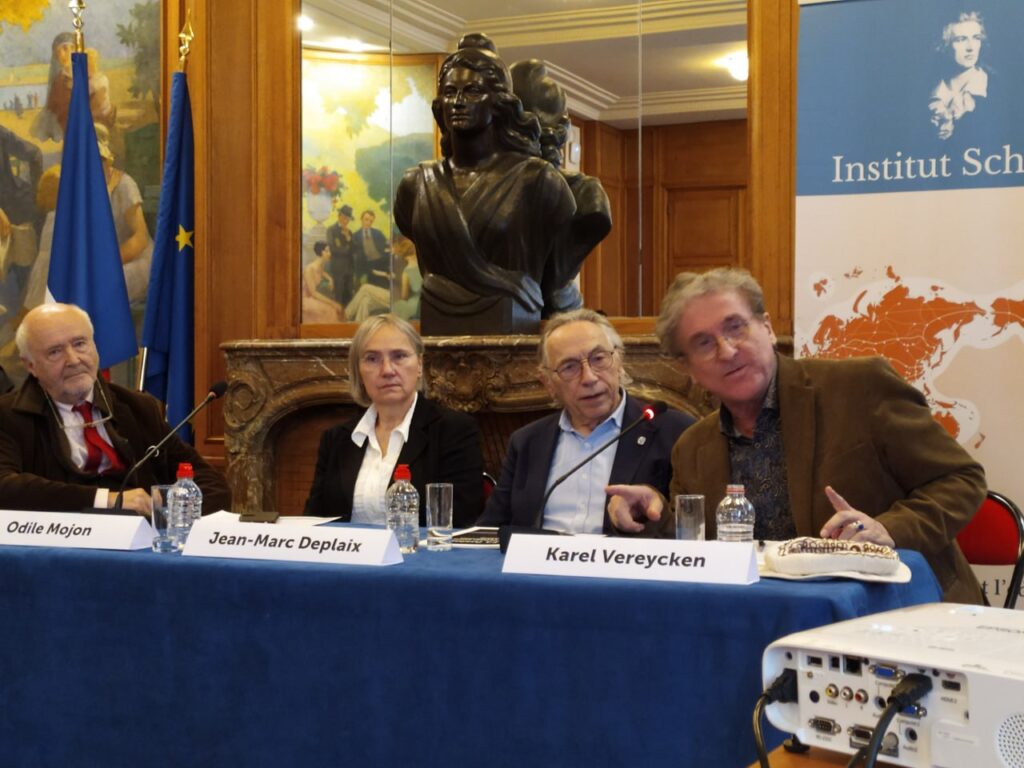
While the dog was domesticated as early as 15,000 years BC, we associate the first human activities aimed at managing water with the Neolithic period, which began around 10,000 BC.
It is thought to be the moment at which mankind moved from a « tribal subsistence economy of hunter-gatherers » to agriculture and animal husbandry, giving rise to villages and cities, where pottery, weaving, metallurgy and the arts would start blooming.
Key to this, the domestication of animals. The goat was domesticated around 11,000 BC, the cow around 9,000 BC, the sheep around -8,000 BC, and finally the horse around 2,200 BC in the steppes of Ukraine.
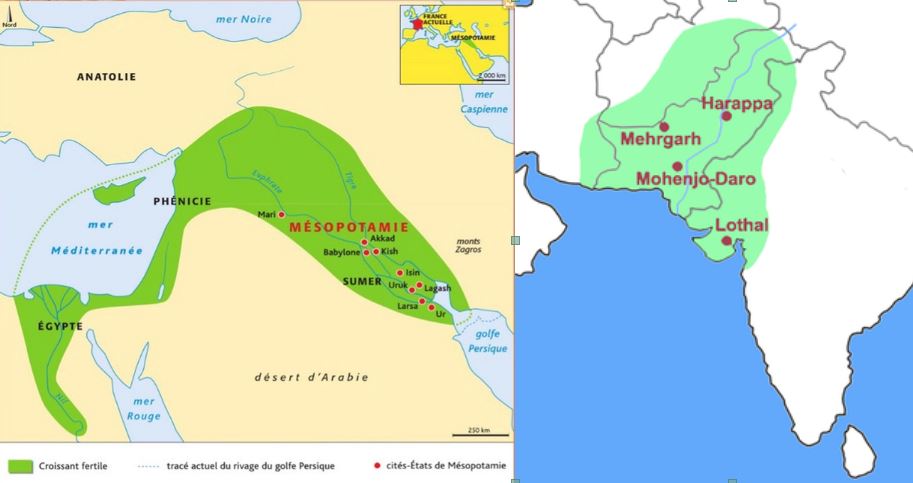
The oldest archaeological sites showing agricultural activities and irrigation techniques were discovered in the Indus Valley and the « Fertile Crescent ».
The site of Mehrgarh, in the Indus Valley, now Pakistan Balochistan, discovered in 1974 by François and Cathérine Jarrige, two French archaeologists, demonstrates important agricultural practices from 7000 BC onward.
Cotton, wheat and barley were grown, and beer was brewed. Cattle, sheep and goats were raised. But Mehrgarh was much more than that.

Contradicting the linear « developmental » schema, since we’re in the middle of the Neolithic, Mehrgarh is also home to the oldest pottery in South Asia and, above all, to the “Mehrgahr amulet”, the oldest bronze object casted with the « lost-wax » method.
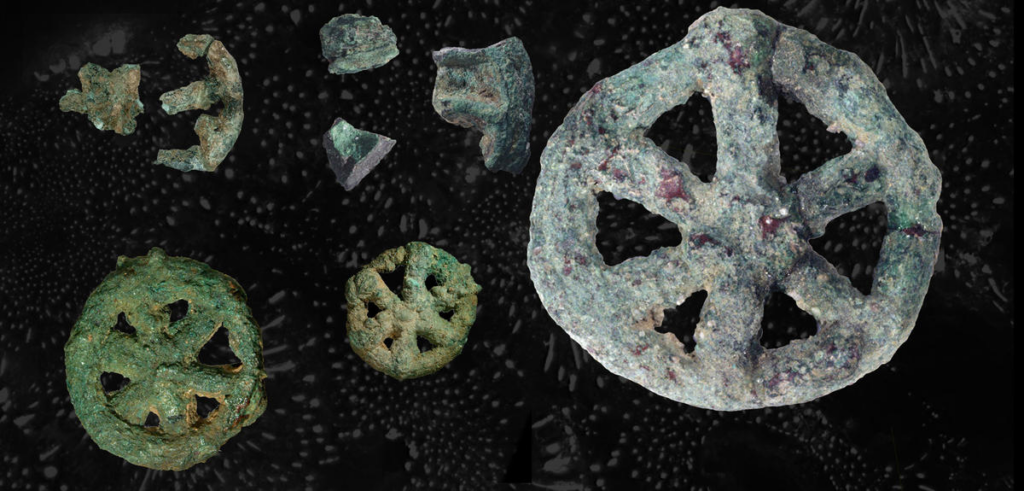
The first seals made of terracotta or bone and decorated with geometric motifs were found here.
On the technological side, tiny bow drills were used, possibly for dental treatment, as evidenced by the pierced teeth of some skeletons found on site.
At the same time, or shortly afterwards, around 6000 B.C., Mesopotamia, between the Tigris and Euphrates rivers, witnessed rapid urban development in terms of demographics, institutions, agriculture, techniques and trade.
A veritable « fertile crescent » emerged in the region stretching from Sumer to Egypt, passing through the whole of Mesopotamia and the Levant, i.e. Syria and the Jordan Valley.
Irrigation
Whether in the Indus Valley, Mesopotamia or Egypt, the earliest irrigation techniques are nothing but retaining as much water as possible when Mother Nature has the sweet kindness to offer it to mankind.
Rainwater was collected in cisterns and, as much as possible, when snowmelt or monsoon rains swell the rivers, the objective was to amplify and steer seasonal « flooding » by canals and trenches carrying the water as far away as possible to areas to be cultivated, while at the same time protecting crops.

In Egypt, for example, where the Nile rises by around 8 meters, the water brings not only moisture but also silt to the soil near the river, providing crops with the nutrients they need to grow and thus maintain the soil’s fertility.
While the Egyptians complained about the harsh labor condition of their farmers, for the Greek historian Herodotus, this was the place in the world where work was least arduous. Of Egypt he says:
“Its soil is black and crumbly, made of silt and alluvium brought from Ethiopia by the river. Certainly, these people are today, of all the human race in Egypt as elsewhere, those who go to the least trouble to obtain their crops.
« They don’t bother to plough and weed. When the river has come of its own accord to water their fields and, its task done, has withdrawn, each man sows his land and lets the pigs loose: by trampling, the beasts sink the seeds into the earth, and the man has only to wait for the harvest.”
In Mehrgarh, where agriculture was born from 7000 BC, the work was indeed far more demanding.
However, the drainage system around the village and the rudimentary dams to control water-logging indicate that the inhabitants understood most of the basic principles involved. The cultivation of cotton, wheat and barley, as well as the domestication of animals, show that they were also familiar with canals and irrigation systems.
Constantly refined, this know-how enabled the civilization of the Indus Valley to create great cities that impress us by their modernity, notably Harappa and Mohenjo Daro, a city of 40,000 inhabitants with a public bath in its center, not a palace.

Pioneers of modern hygiene, these towns were equipped with small containers where residents could deposit their household waste.
Anticipating our « all-to-the-sewer » systems imagined in the early XVIth century by Leonardo da Vinci, for example in his plans for the new french capital of Romorantin, many towns had public water supplies as well as an ingenious sewage system.
In the port city of Lothal (now India), for example, many homes had private brick bathrooms and latrines. Wastewater was evacuated via a communal sewage system leading either to a canal in the port, or to a soaking pit outside the city walls, or to buried urns equipped with a hole for the evacuation of liquids, which were regularly emptied and cleaned.
Excavations at the Mohenjo Daro site reveal the existence of no fewer than 700 brick wells, houses equipped with bathrooms and individual and collective latrines.

Many of the city’s buildings had two floors or more. Water trickled down from cisterns installed on the roofs was channeled through closed clay pipes or open gutters that emptied into the covered sewers beneath the street.


This hydraulic and sanitary know-how was passed on to the civilization of Crete, the mother of Greece, before being implemented on a large scale by the Romans.
It was forgotten with the collapse of the Roman Empire, only to return during the Renaissance.

The first human contributions were aimed at maximizing water reservoirs and their gravity-flow capacity. To achieve this, it was necessary to transfer water from a lower level to higher ground and build « water towers ».
To this end, the Mesopotamian « chadouf » was widely used in Egypt, followed by the « Archimedean screw ».
Next came the « saquia » or « Persian wheel », a geared wheel driven by animal power, and finally the « noria », the best-known water-drawing machine, powered by the river itself.
Persian qanats
Before Alexander the Great, Persia’s Achaemenid Empire (6th century BC) developed the technique of underground qanats or underground aqueducts. This « draining gallery” cut into the rock or built by man, is one of the most ingenious inventions for irrigation in arid and semi-arid regions.
Whatever displeases our environmentalist friends, it’s not nature that magically produces « oases » in the desert.
It’s a scientific man who digs a drainage gallery from a water table close enough to the ground surface, or sometimes from an aquifer that flows into the desert.
On the website of ArchéOrient, archaeologist Rémy Boucharlat, Director of Emeritus Research at the French CNRS, an expert on Iran, explains:
« Whatever the origin of the water, deep or shallow, the gallery construction technique is the same. The first step is to identify the presence of the water, either its underflow near a river, or the presence of a deeper water table on a foothill, which requires the science and experience of specialists.
A motherwell reaches the upper part of this layer or water table, which indicates the depth at which the gallery should be dug. The slope of the gallery must be very shallow, less than 2‰, to ensure a calm and regular flow of water, and to gradually lead the water to the surface, at a gradient much lower than the slope of the piedmont.
The gallery is then excavated, not from the mother well, as it would be flooded immediately, but from downstream, from the arrival point. The pipe is first dug as an open trench, then covered, and finally gradually tunnelled into the ground.
Shafts are dug from the surface at regular intervals, between 5 and 30 m depending on the nature of the terrain, to evacuate soil and provide ventilation during excavation, and to mark the direction of the tunnel.”

Historically, the majority of the populations of Iran and other arid regions of Asia and North Africa depended on the water supplied by qanats; settlement areas thus corresponded to the places where their construction was possible.
The technique offers a significant advantage: as the water moves through an underground conduit, not a drop of water is lost through evaporation.
This technique spread throughout the world under various names: qanat and kareez in Iran, Syria and Egypt, kariz, kehriz in Pakistan and Afghanistan, aflaj in Oman, galeria in Spain, kahn in Balochistan, kanerjing in China, foggara in North Africa, khettara in Morocco, ngruttati in Sicily, bottini in Siena, etc.).
Improved by the Greeks and amplified by the Etruscans and the Romans, the qanats technique was carried by the Spaniards across the Atlantic to the New World, where numerous underground canals of this type still operate in Peru, Chile and western Mexico.
After Alexander the Great, Bactria, covering parts of today’s Uzbekistan, Turkmenistan and the northern part of Afghanistan, was even known as the « Oasis civilization » or the “Land of a 1000 Golden Cities”.
Iran boasts it had the highest number of qanats in the world, with approximately 50,000 qanats covering a total length of 360,000 km, about 9 times the circumference of the Earth !
Thousands of them are still operational but increasingly destabilized by erratic well digging and demographic overconcentration.
Shared responsability
In 1017, the Baghdad-based hydrologist Mohammed Al-Karaji provided a detailed description of qanat construction and maintenance techniques, as well as legal considerations about the collective management of wells and pipes.
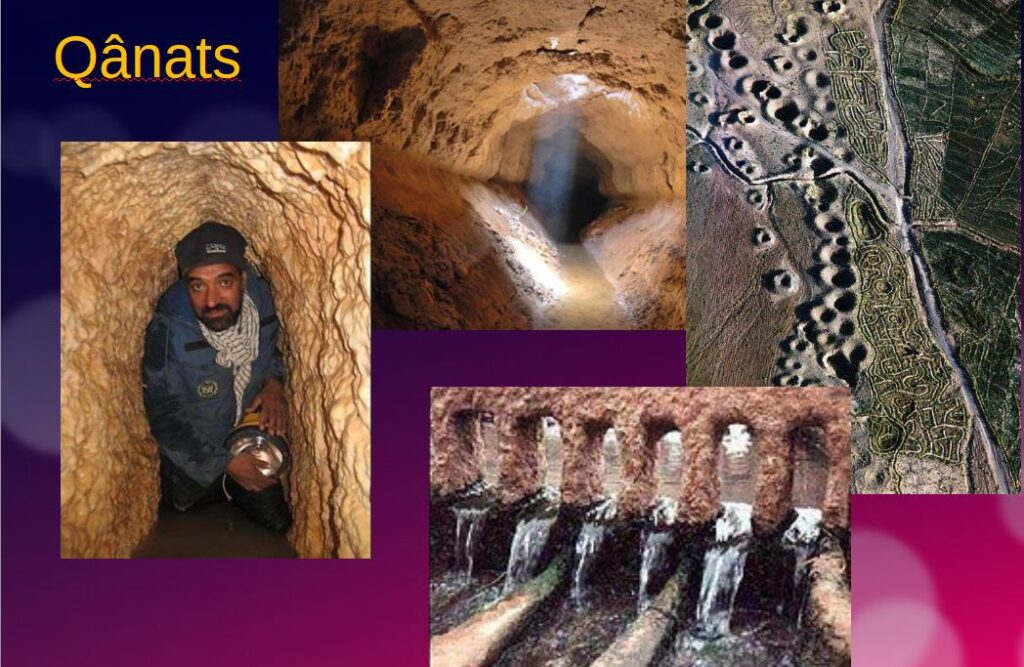
While each qanat is designed and supervised by a mirab (dowser-hydrologist and discoverer), building a qanat is a collective task that takes several months or years for a village or group of villages. The absolute necessity of collective investment in the infrastructure and its maintenance calls for a superior notion of the common good, an indispensable complement to the notion of private property that rains and rivers are not accustomed to respecting.
In North Africa, the management of water distributed by a khettara (the local name for qanâts) is governed by traditional distribution norms known as « water rights ».
Originally, the volume of water granted per user was proportional to the work involved in building the khettara, and translated into an irrigation period during which the beneficiary could use all the khettara’s flow for his or her fields. Even today, when the khettara has not dried up, this rule of water rights still applies, and a share can be bought or sold. The size of each family’s fields to be irrigated must also be taken into account
All of this demonstrates that good cooperation between man and nature can do miracles if man decides so.
Thank you for your attention and questions welcome!

Posted in Comprendre, Etudes historiques, politiques et scientifiques | Commentaires fermés sur The science of Oases, from the Indus Valley to Persian qanats
Tags: Afghanistan, Alexander the Great, archimedes, artkarel, Babylon, Bactria, Bagdad, Balk, canals, chadouf, draining, Egypte, flood control, flooding, galerias, Harappa, Indus Valley, irrigation, Jordan, Karel, Karel Vereycken, Mesopotamia, Mohenjo Daro, Nile, noria, oases, Oasis, Persia, persian wheel, qanat, raising, renaissance, seasonal, silt, Sumer, Ur, Vereycken, water
Posted by: Karel Vereycken | on janvier 7, 2023
The challenging modernity of the Indus Valley Civilization

Get an easy-to-print pdf file of this article
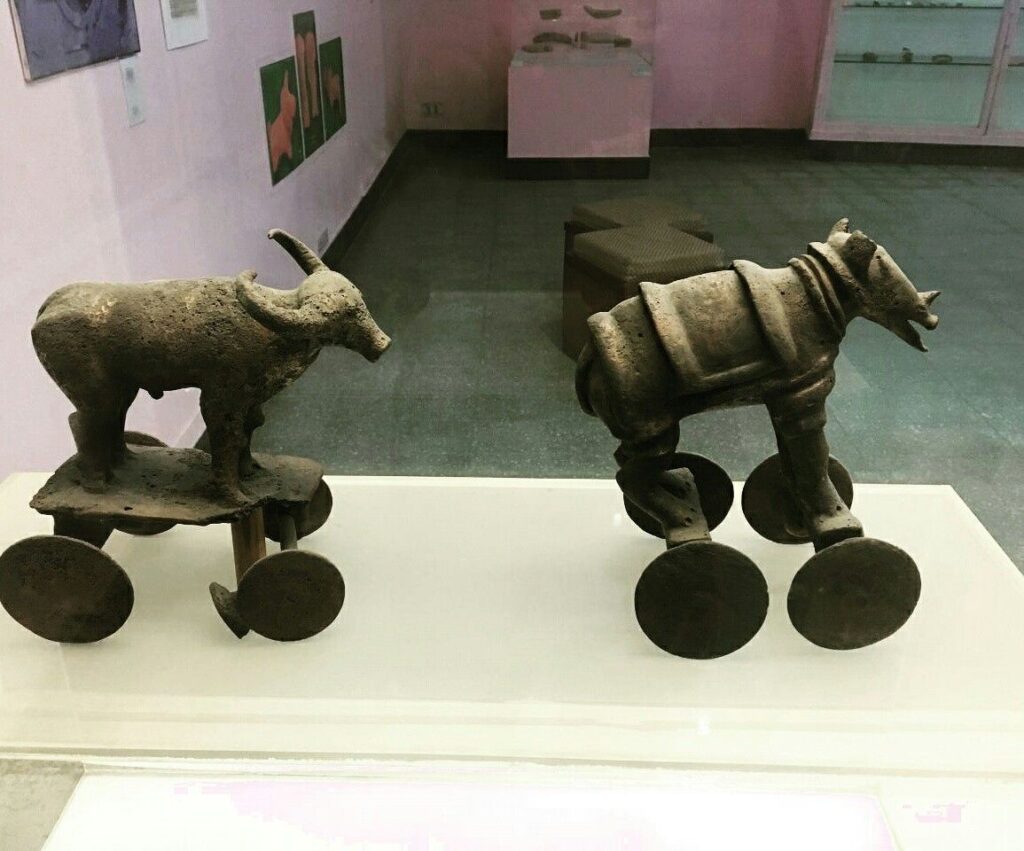
Karel Vereycken, Paris, France, January 2023
A major archaeological discovery has just been made in Israel in 2022: the first evidence of the use of cotton fibers in the Near East and among the oldest in the world, dating back nearly 7,000 years, was discovered by Israeli, American and German archaeologists during an archaeological excavation at Tel Tsaf, southeast of Beit She'an, in the Jordan Valley of Israel.
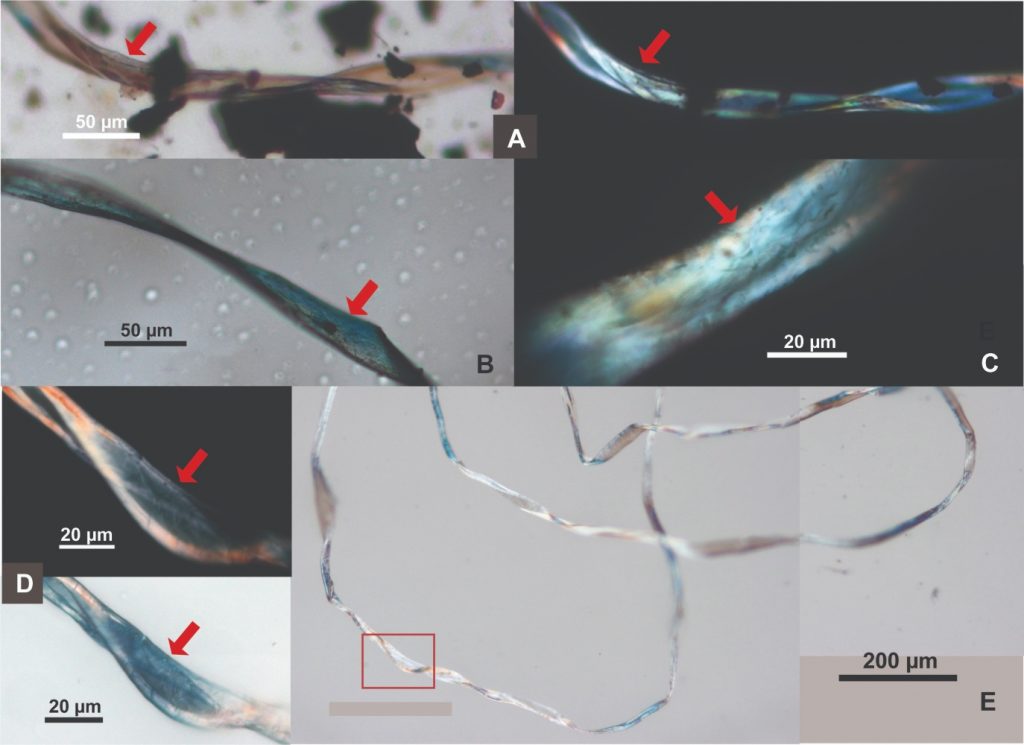
So far, the earliest available evidence of cotton fibers in the area was dated to a few hundred years later, to the late Chalcolithic (Copper Age) and Early Bronze Age (about 5,000 to 6,500 BCE) from the archaeological site of Dhuweila in eastern Jordan.
Discovered in 1940, the site of Tel Tsaf reveals its secrets. « Tsaf is characterized by an amazing preservation of organic materials, » said Professor Danny Rosenberg of the Zinman Institute of Archaeology at the University of Haifa. « Tel Tsaf was a kind of pole that concentrated important commercial activities and had established contacts with many other peoples, » Rosenberg believes. « There was massive storage capacity there to accommodate grain, enormous capacity if you compare it to other sites.
For example, the earliest evidence of the social use of beer drinking and ritual food storage has been found there. Rosenberg and the other researchers also found beads from contemporary Anatolia, Romania, Egypt and other parts of Africa; pottery from Iraq, Syria and Armenia; and the earliest copper and other metals found in the world.
“Wool Tree” and “Cotton Roads”

The cotton found in Israel, probably came from the Indus region—modern Pakistan/India—which was the only place in the world that had begun to domesticate cotton at that time before its cultivation appeared in Africa thousands of years later.
« What’s interesting about this early evidence of a link to such a distant region is that it comes from fibers – microscopic pieces of ancient yarn. We assume that these cotton fibers, found along with wool fibers and plant fibers, arrived at the site as part of fabrics or clothing, i.e., ancient textiles, » Rosenberg says.
In addition, cotton was not only used for clothing: « In the prehistoric era, textiles were involved in many areas of life, not only in clothing but also in hunting, fishing … This is much more important than just saying that what we found are pieces of clothing that were worn by the inhabitants of the area. This discovery tells us a lot about the economic practices of the area, » says Rosenberg.
Since cotton had never been grown in Tel Tsaf, it was a surprise for the researchers to find it, and they felt that its presence underscored the city’s importance as a global trading hub at the heart of what could be called, the « Cotton Roads » of those days.
Growing cotton poses major challenges: a moderate to tropical climate and vast amounts of water. Just to produce a single T-shirt and a pair of jeans (representing about 1 kg of cotton), no less than 20,000 liters of water are required! Which civilization can afford such a performance at the beginning of the 7th millennium BC?
The Indus Valley civilization (IVC)

The term « Indus Valley Civilization » (IVC) refers to a vast cultural and political entity that flourished in the northern region of the Indian subcontinent between about 8000 and about 1900 BCE., a region that stretched from Baluchistan (Pakistan) in the west to Uttar Pradesh (India) in the east and from northeastern Afghanistan in the north to Gujarat (India) in the south.
In the absence of both literary sources and remnants of palaces and temples to confirm it, one cannot qualify this entity as a “Kingdom” or an “Empire”. Its modern name (IVC) derives simply from its location in the Indus Valley, but also goes under the name of the « Indus-Sarasvati civilization » or « Harappan civilization ». These last designations come from the river Sarasvati, mentioned in the Vedic sources, which flowed next to the Indus and which would have disappeared, and from the ancient city of Harappa (Punjab, Pakistan), discovered by the British in 1829, but deliberately left unexplored.
The rise of a great urban civilization in the Indus Valley, which reached its maturity around 2500-2400 BCE, was long considered a sudden and mysterious phenomenon. Today, a series of discoveries allows us to follow, from 7000 to 2500 BCE, a series of transformations and innovations whose cumulative effects, stimulated by the enlargement of the network of exchanges from 3000 BCE onwards, created the conditions for the development of an incredibly modern and prosperous urban civilization.
Enter Mehrgarh, the light of the world!
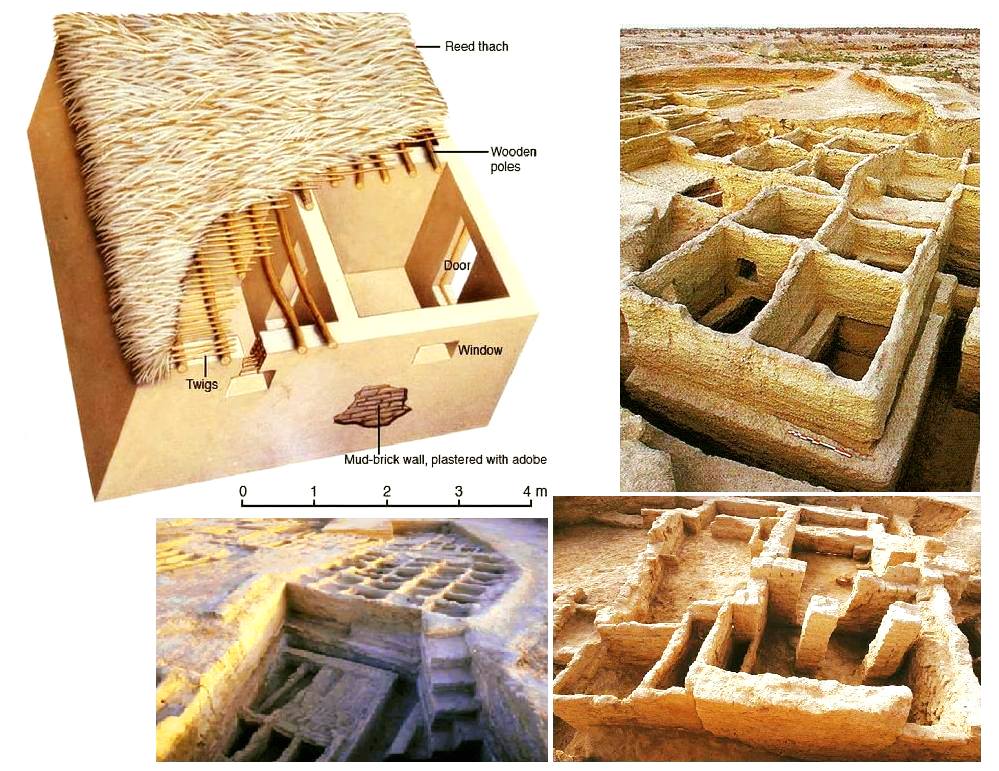
Since prehistoric times, the Indus region has been pioneering and rich in discoveries. As an example, for the Guinness Book of Records, although a case apart, the farming village of Mehrgarh (Baluchistan, Pakistan) which dates from the Neolithic (using only stones as tools) but can be considered as the key culture and city that lead humanity, as early as in the 8th millennia BCE, from the Stone Age into the Age of Copper.
The site is located on the principal route between what is now Afghanistan and the Indus Valley: this route was also undoubtedly part of a trading connection established quite early between the Near East and the Indian subcontinent.
Excavations in Mes Aynak (Afghanistan), where archaeologists are only beginning to find remnants of a 5,000-year-old Bronze Age site beneath the Buddhist level, including an ancient copper smelter, will undoubtedly shed new light on these relationships.
On the basis of a variety of well-documented archaeological finds, it has been established that “pre-Harrapan” Mehrgarh, made several historical breakthroughs for the benefit of humanity as a whole.
Mehrgarh gave the world:
- among the oldest traces of agriculture (wheat and barley) and breeding (cattle, sheep and goats) in South Asia ;
- the first breweries (with wheat and barley);
- the oldest reservoirs for irrigated agriculture and flood prevention;
- the oldest traces of cotton culture (6th millennium BCE);
- the oldest jewel, called the « Mehrgarh amulet » (6th millennium BCE), produced with the « lost wax » bronze casting technique ;
- the oldest bow drills (in green jasper) allowing to drill holes in lapis lazuli and carnelian;
- the very first traces of successfull dentistry practices (!) (9th millennium BCE); The inhabitants of Mehrgarh appeared to have developed an understanding of surgery and dentistry, as evidenced by the drilled teeth of some of the skeletons found at the site. Analysis of the teeth shows that prehistoric dentists worked to treat toothaches with drills made from flint heads. The work was so elaborate that even modern dentists are surprised at the efficiency with which the Mehrgarh « dentists » removed decaying tooth tissue. Among the remains, a total of eleven drilled crowns were found, with one example showing evidence of a complex procedure involving the removal of tooth enamel followed by carving of the cavity wall. Four of the teeth show evidence of decay associated with the drilled hole. None of the individuals with drilled teeth appear to have come from a special tomb or shrine, indicating that the oral health care they received was available to all.

Densely populated
Originally, the IVC was built around the fishy meanders of the Indus, a river nearly 3200 kilometers long that flows from the Himalayan mountains towards the Arabian Sea. Like the populations of other great river valleys, this society was seduced by the fertility of the land as well as by the possibility of using the Indus as a transportation route.
The IVC, whose prosperity rests largely on the increasingly systematic exploitation of the rich silt of the Indus, spread over an immense territory encompassing the entire Indus Valley and part of Indian Gujarat. It is necessary to add to the vast zone of distribution of the Indus civilization some Harappan « colonies » or outposts like Sutkagan Dor (Ballochistan, Pakistan), close to Gwadar on the edges of the sea of Oman, at the Iranian-Pakistani border, and the lapus lazuli mining town of Shortugai, close to Amu Darya river, at the Afghan-Tajik border, at nearly 1,200 kilometers of Mohenjo-daro, by far the largest IVC urban concentration.

At its peak, this civilization was twice as large as the Old Kingdom of Egypt. With an area of 2.5 million square kilometers, it was at the time the largest civilization in the world: it included 5 million people, or 10 % of the world population at the time, much more than less older civilizations as Sumer (0.8 to 1.5 million people) or ancient Egypt (2 to 3 million).
To date, about 2,000 sites have been discovered in India, Pakistan and Afghanistan. Because of various wars and conflicts, only 10 % of the territory of these sites has been excavated and scientifically investigated. On the Indian subcontinent, the main centers of this civilization are Harappa (estimated 23,500 inhabitants) and Mohenjo-daro (est. 40,000 inhabitants) in Pakistan and Lothal, Dholavira and Kalibangan in India. In addition to trade relations with Mesopotamia and Iran, the Harappan city-states also maintained active trade relations with the peoples of Central Asia.
Agriculture, crafts and industry
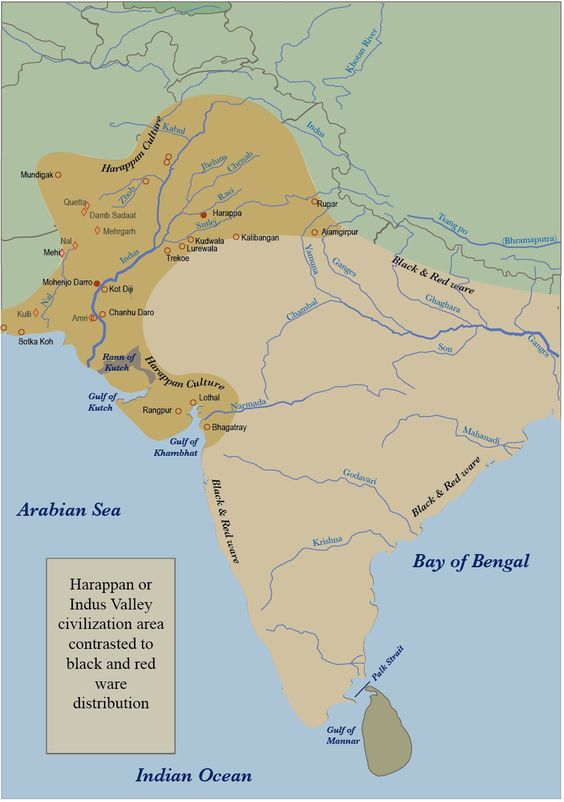
Agriculture, animal husbandry, industry, trade and commerce were the main source of income.
Agriculture was the main occupation of the people of the Indus Valley. They cultivated barley and wheat on a large scale (and made beer) but also other crops such as legumes, cotton, cereals, sesame, dates, mustard, melons, peas, etc.
There is no real evidence of rice, but a few grains of rice have been found in Rangpur and Lothal.
In the towns of Mehrgarh, Harappa, and Mohenjo-daro, there are remains of large granaries, suggesting that they produced more than they needed and physically stocked cereals and other food products in case of crop failure.

Animal husbandry was another major occupation. Seals suggest that they domesticated cows, buffalos, goats, sheep, pigs, etc. Camels and bullocks were also domesticated and used as beasts of burden. Camel bones have been found in large numbers at many sites, but there is no trace of them on the seals. During the excavation of Surkotado in Gujarat, India, the jawbone of a horse was found. Terracotta figurines representing a horse were found in Nausharo and Lothal.
The inhabitants of the Indus Valley were very skillful. They made ceramics, metal vessels, tools and weapons, weaved and spun, dyed and practiced other crafts with potter’s wheels. The weavers wore clothes made of cotton and wool. They knew leather, but there is no record of silk production.

The inhabitants of this civilization originally came from the Bronze Age and used stone tools, but they soon excelled in the manufacture and processing of gold, silver, copper, lead and bronze, especially for artistic ornaments of great finesse.
Artisans made jewelry in Mohenjo-daro, Chanho-daro and Lothal. They used ivory and various precious stones such as carnelian, lapis lazulite, agate and jasper to make them. Shell work was also a thriving industry. Craftsmen in the coastal colonies used shells to make buttons for shirts, pendants, rings, bracelets, beads, etc.
To supply the production of these craft professions, they needed to import various raw materials. To produce bricks and ceramics, clay was available locally, but for metal they had to acquire it from abroad. Trade focused on importing raw materials to be used in Harappan city workshops, including minerals from Iran and Afghanistan, lead and copper from other parts of India, jade from China, and cedar wood floated down rivers from the Himalayas and Kashmir. Other trade goods included terracotta pots, gold, silver, metals, beads, flints for making tools, seashells, pearls, and colored gemstones, such as lapis lazuli and turquoise.
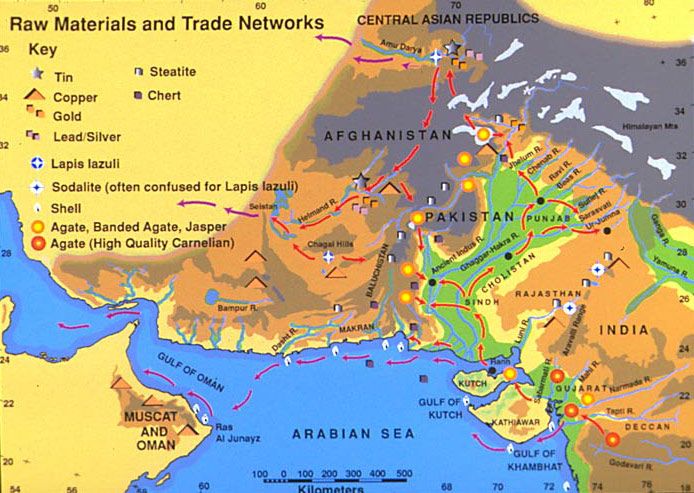
Ox carts were used to transport goods from one place to another. They also constructed barges used on the waterways along the Indus and its tributaries for transportation.
One of the ways historians know about the maritime trade network operating between the Harappan and Mesopotamian civilizations is the discovery of Harappan seals and jewelry at archaeological sites in regions of Mesopotamia, which includes most of modern-day Iraq, Kuwait, and parts of Syria. Long-distance sea trade over bodies of water—such as the Arabian Sea, Red Sea and the Persian Gulf—may have become feasible with the development of plank watercraft that were each equipped with a single central mast supporting a sail of woven rushes or cloth.

Historians have also made inferences about networks of exchange based on similarities between artifacts across civilizations.
Between 4300 and 3200 BCE, ceramics from the Indus Valley Civilization area show similarities with southern Turkmenistan and northern Iran. During the Early Harappan period—about 3200 to 2600 BCE—there are cultural similarities in pottery, seals, figurines, and ornaments that document caravan trade with Central Asia and the Iranian plateau.
The wonders of Mohenjo-daro
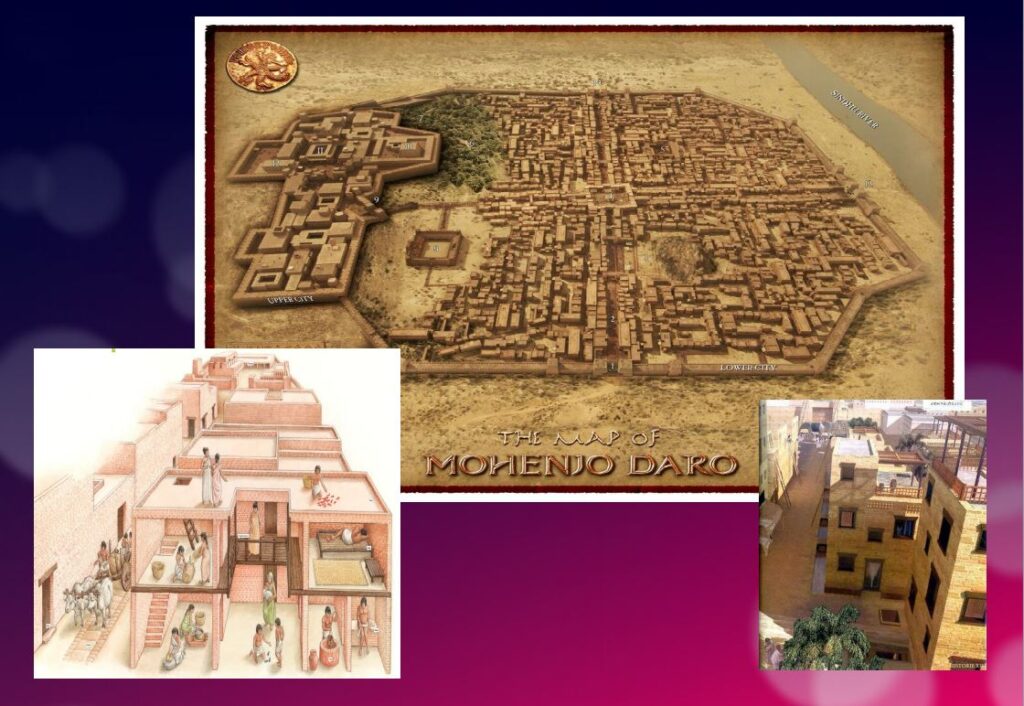
Sometimes referred to as the « Manhattan of the Bronze Age » for the grid pattern of the city plan, Mohenjo-daro (Sind, Pakistan) remained buried under meters of alluvial sediment until 1922.
A real metropolis made of baked bricks, it covers more than 200 hectares. Strictly squared, cut in two by a street of ten meters wide, divided from north to south by a dozen arteries drawn with the cord, and crossed from east to west by paved streets, Mohenjo-daro represents, by its strictly reflected urban framework, the model city of the Indus civilization. It could have accommodated up to 40,000 people!
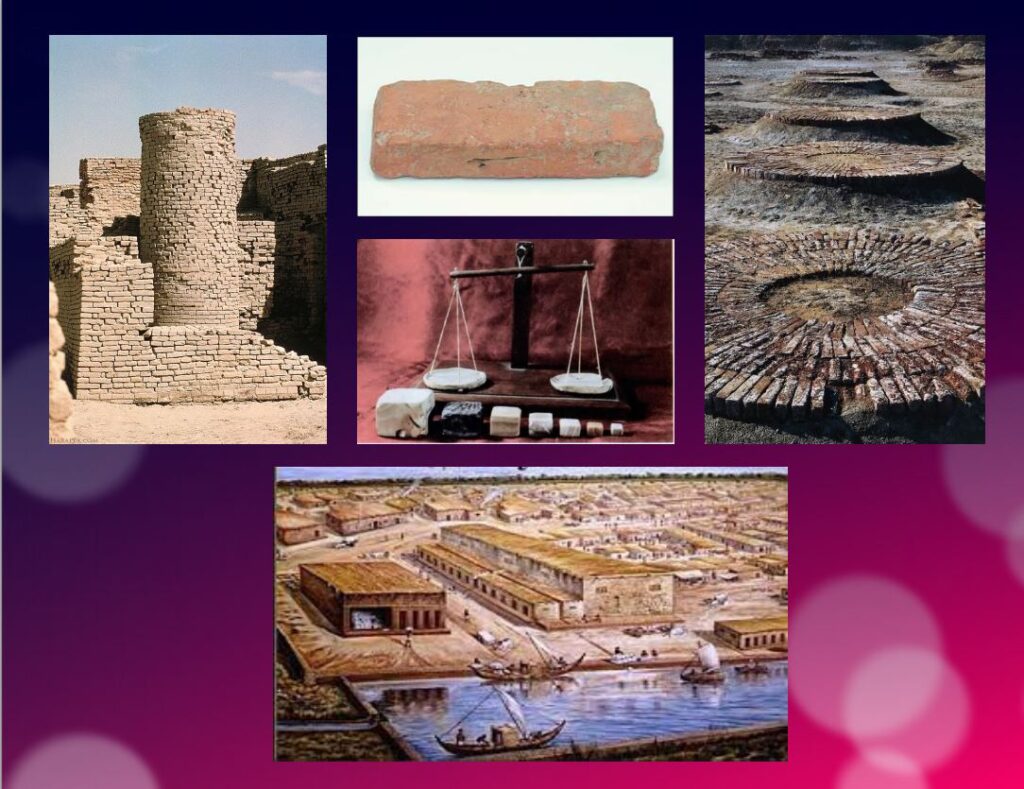
The Harappans were masters of hydraulic engineering, a “riparian” people working in river corridors practicing irrigated agriculture. They mastered both the shaduf (an irrigation tool used to draw water from a well), and windmills.
In the Harappan cities, the domestic and manufacturing areas were separated from each other.
The inhabitants, living in one-, two-, and sometimes three-story dwellings, seem to have been mainly artisans, farmers, and merchants. The people had developed the wheel, cattle-drawn carts, flat-bottomed boats large enough to carry goods, and perhaps also sailing. In the field of agriculture, they had understood and used irrigation techniques and canals, various agricultural implements, and had established different areas for livestock grazing and cultivation.
Seals and harrapan script
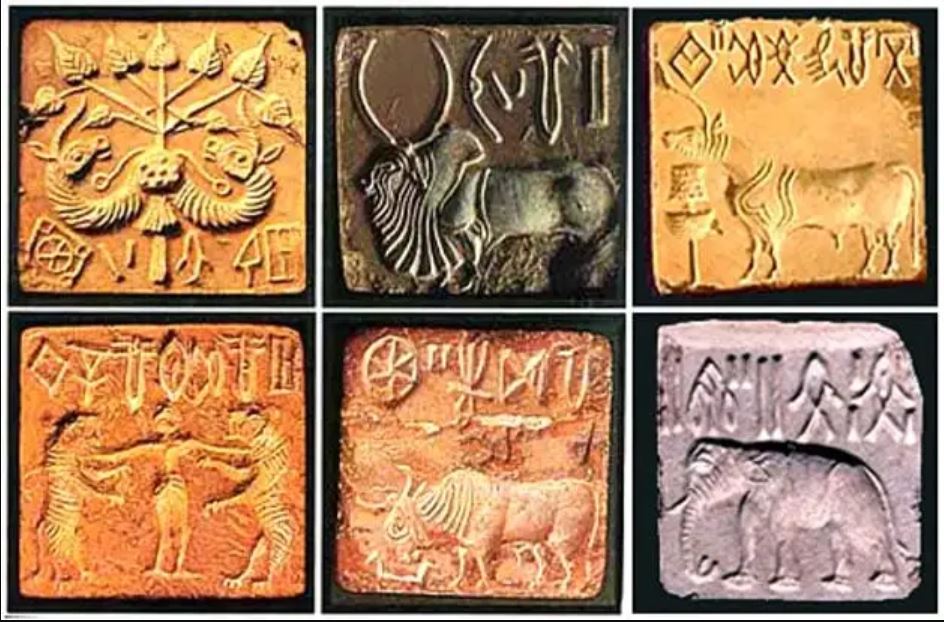
Among the thousands of artifacts found at the various sites are small soapstone seals just over one inch (3 cm) in diameter, used to sign contracts, authorize land sales, and authenticate the point of origin, shipment, and receipt of goods in long-distance trade. On each seal is a small text in Harappan, a language yet to be deciphered.
Among the thousands of artifacts found at the various sites are small soapstone seals just over one inch (3 cm) in diameter, used to sign contracts, authorize land sales, and authenticate the point of origin, shipment, and receipt of goods in long-distance trade.
Commercial contacts between the Indus and Sumer populations are well documented. Numerous seals from the Indus Valley have been discovered in Mesopotamia. On each seal, a small text in Harappean, a language that remains to be deciphered.
If 4,200 texts reached us, 60 % of them are seals or mini-tablets of stone or copper, engraved, and they comprise on average… only five signs! The longest text has 26 signs. The texts are always accompanied by the image of an animal, often a unicorn or a majestic buffalo. They were intended to mark goods, probably indicating the name of the owner or the recipient and a quantity or a year. Trying to decipher the Indus language is a bit like trying to learn French only from the labels on the food shelf of a supermarket!
The invention of sanitation
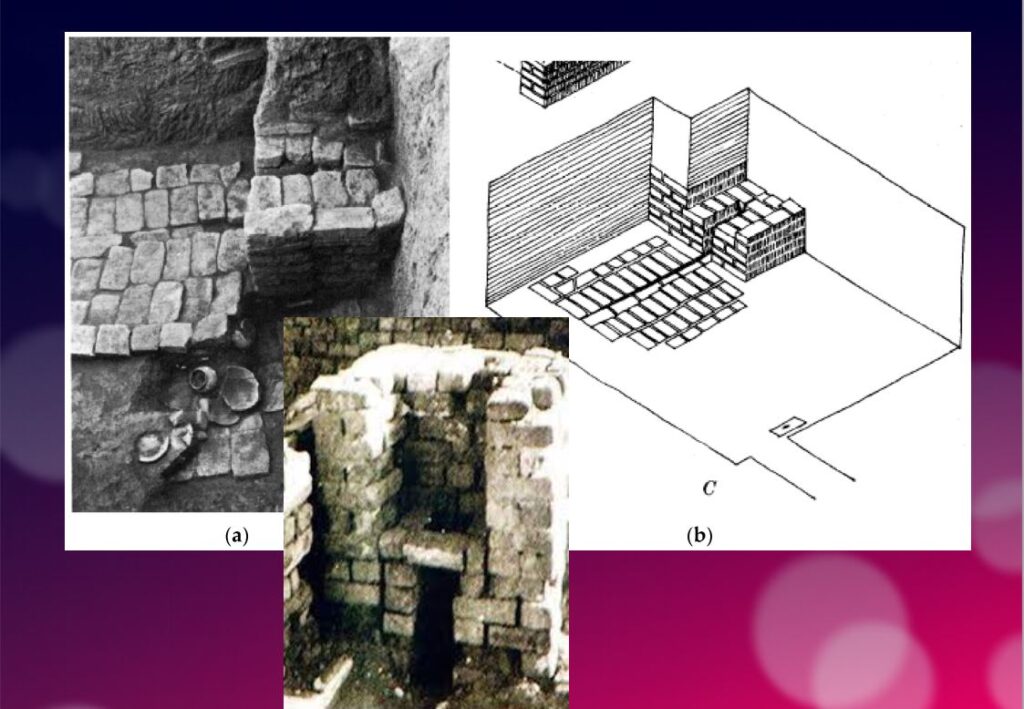
In addition to this particular attention that they paid to urban planning, the members of the Indus civilization also seem to have been pioneers of modern hygiene. Some cities, notably Mohenjo-daro, were equipped with small containers (dustbins) in which the inhabitants could deposit their household waste.
Anticipating our « all to the sewer » systems imagined in the 16th century by Leonardo da Vinci for the project envisaged by François I for the new French capital Romarantin, many cities had already public water supply and an ingenious sanitation system.
In many cities, including Mohenjo-daro, Harappa, Lothal and Rakhigari, individual houses or groups of houses were supplied with water from wells. This quality fresh water was used as much for food and personal hygiene (baths, toilets) as for the economic activities of the inhabitants.

As an example, the sanitation system of the port city of Lothal (Gujarat, India) where many houses had a bathroom and private brick latrines. The wastewater was evacuated through a communal sewer system that led either to a canal in the port, or to a soaking pit outside the city walls, or to buried urns equipped with a hole allowing the evacuation of liquids, which were regularly emptied and cleaned.
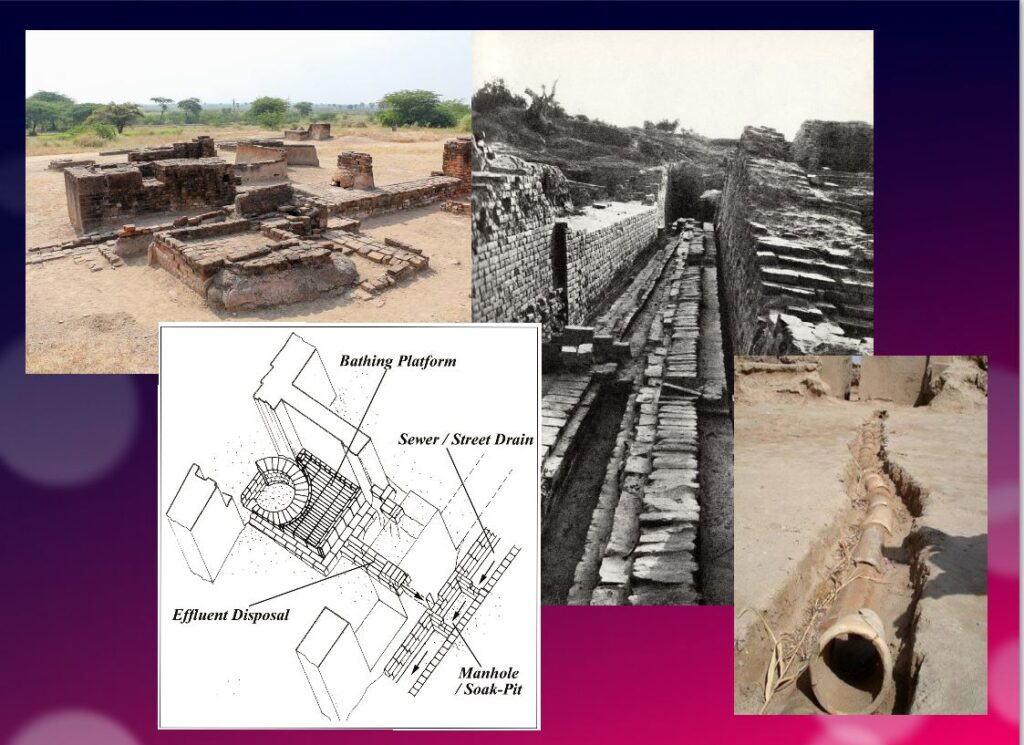
Excavations at the Mohenjo-daro site have also revealed the existence of no less than 700 brick water wells, houses equipped with bathrooms and individual and collective latrines. Toilets were an essential element. However, early archaeologists erroneously identified most toilets as post-cremation burial urns or simple cesspools. Many buildings in the city were two or more stories high. Water from the roof and bathrooms of the upper floors was channeled through closed clay pipes or open troughs that emptied, if necessary via the toilets, into the covered sewers underneath the paved street.
This extraordinary achievement is confirmed by a 2016 scientific study, entitled « The Evolution of Toilets Around the World Across the Millennia, » which reports that,
The earliest multi-flush toilets connected to a sophisticated sewage system that have been identified so far were found in the ancient cities of Harappa and Mohenjo-Daro in the Indus Valley, dating from the middle of the third millennium BC. Nearly every dwelling unit in Harappa, Mohenjo-Daro, and Lothal was equipped with a private bath-toilet area with drains to carry dirty water into a larger drain that emptied into the sewer and drainage system.
Till now, it are the Minoan (Crete) civilization and China that have been credited for the first use of underground clay pipes for sanitation and water supply. In the Cretan capital Knossos, there was a well-organized water system to bring in clean water, to evacuate wastewater and to provide storm sewers for overflow in case of heavy rains.
In Knossos existed also one of the earliest uses of flush toilets, dating back to the 18th century BCE. The Minoan civilization had stone sewers that were periodically cleaned with clean water. Crete, of course, was a large provider of Copper ore for the entire world in Antiquity and had vast international trade connections.
Religious and cultural worldview
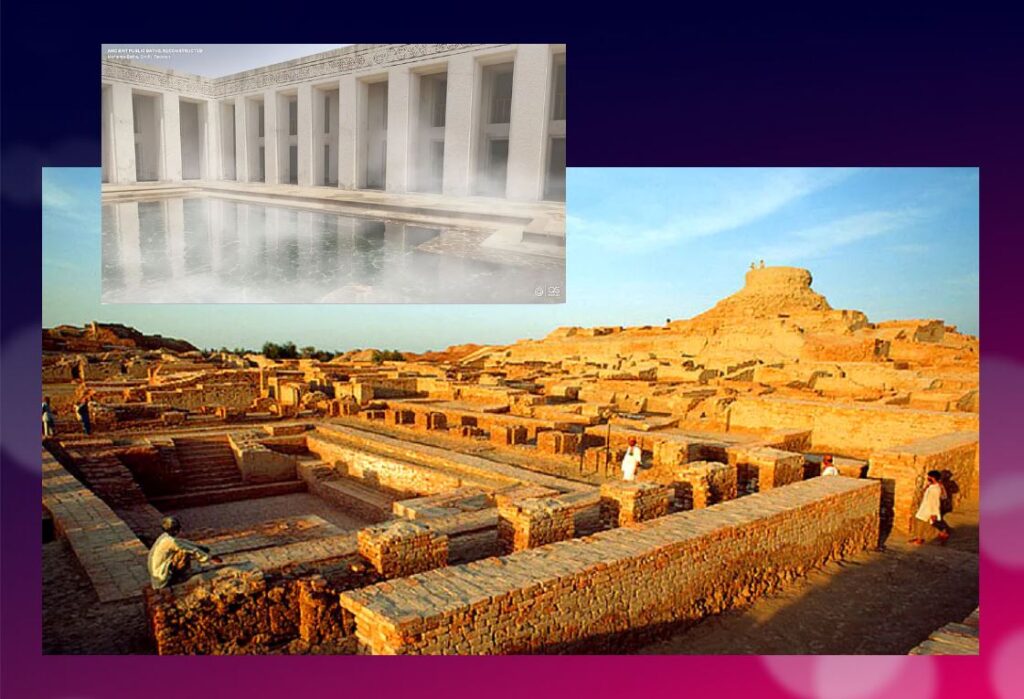
In the IVC, fertility rituals were probably observed in order to promote a full harvest as well as for women’s pregnancies, as evidenced by a number of figurines, amulets and statuettes with female form.

It is thought that the people, like the Dravidians who some believe were the origin of the Indus Civilization, worshiped a “mother goddess” and possibly a male companion represented as a horned figure in the company of wild animals.
The « Great Bath » at Mohenjo-daro would have been used for purification rites related to religious belief, but it could just as easily have been a public pool for recreation. Our knowledge of the religious beliefs of this culture remains in the realm of mere hypothesis.
The title of the famous statue of the « Priest-King » found at Mohenjo-daro is misleading, as there is no evidence that it is a king or a priest, and it may be a simple cotton trader…
Apart from pottery, certain types of elementary weapons (spearheads, axes, arrows, etc.) and certain tools for practical purposes, two types of artifacts give us cultural clues about Harappean society.

First, some figurines, which we try to interpret as devotional objects, seem to be simple toys. For others, they are clearly toys, notably animals (oxen, buffaloes, elephants, goats and even a simple hen), made of bronze or terracotta, mounted on small carts with wheels.
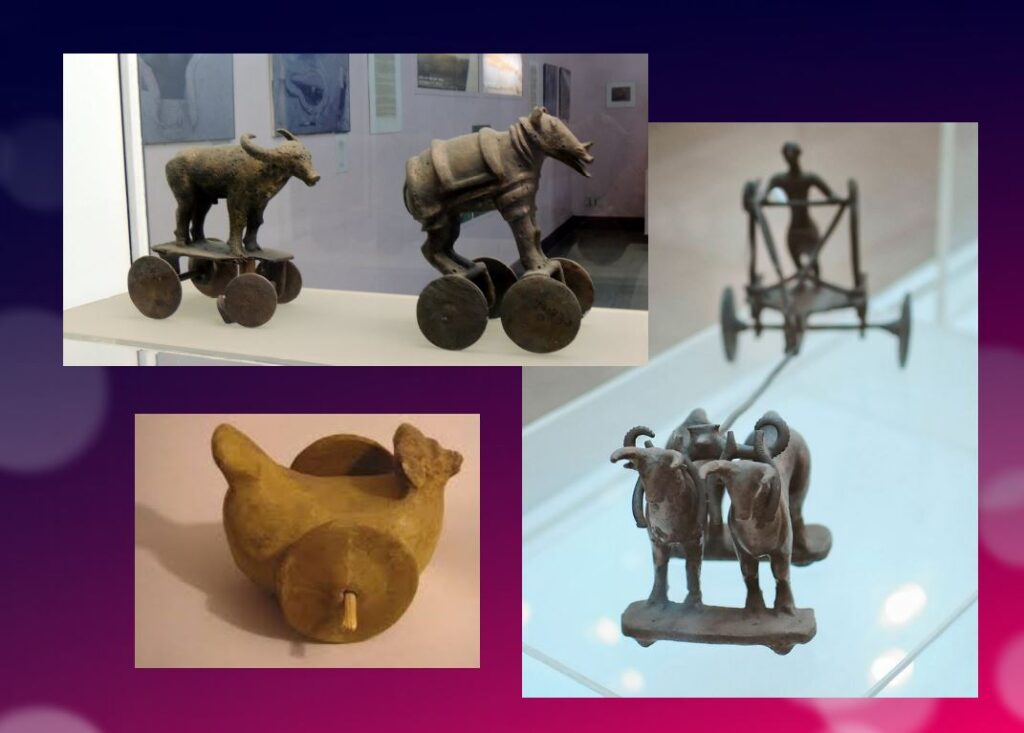
Second, among other objects expressing a high level of sensitivity and consciousness, a series of masks, some of which seem inspired by Mongolian masks.
These masks are clearly intended to serve comic or tragic representations and remind us of the ancient masks that have come down to us from classical Greece.
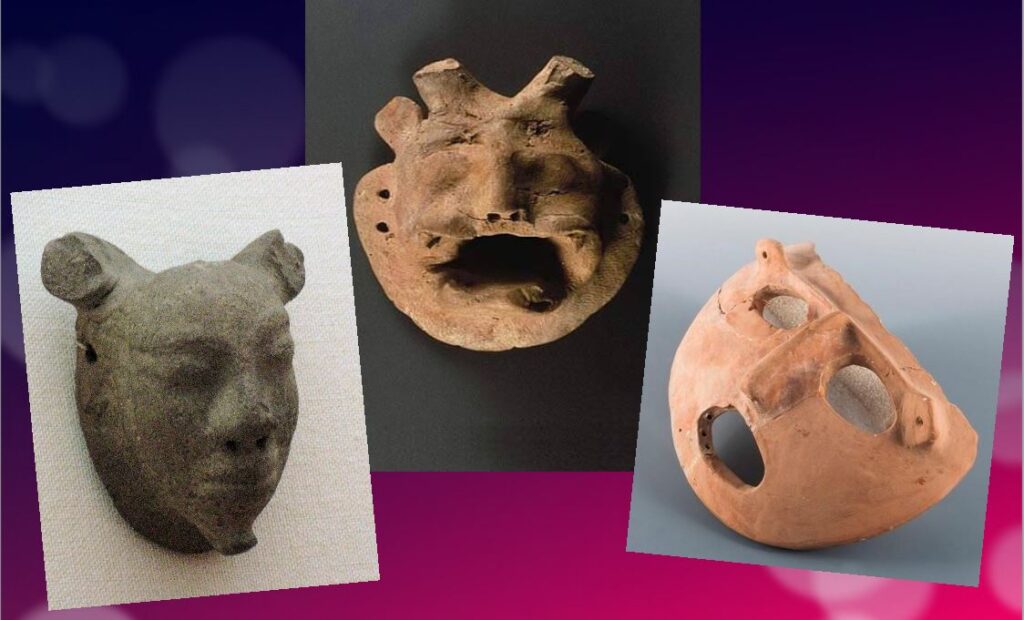
Older than Sumer and Egypt?
Archaeological excavations of the IVC got off to a late start, and it is now believed that some of the achievements and « firsts » attributed to Egypt ( – 3150 BC) and Mesopotamia ( – 4500 BC) may in fact belong to the inhabitants of the Indus Valley civilization.
In May 2016, the report published by a team of researchers from IIT Kharagpur, Institute of Archaeology, Deccan College Pune, Physical Research Laboratory and Archaeological survey of India (ASI), published by the journal Nature, shattered a number of “facts” that were considered unshakeable certainties.
Until now, the 900 years of the « mature » phase of the IVC was dated as ranging from 2800 to 1900 BCE. However, the aforementioned Indian study indicates that this civilization was much older than previously thought – it is at least 8,000 years old!
To determine the age of this civilization, researchers dated pottery using a technique called optically stimulated luminescence (OSL) – and found it to be nearly 6,000 years old, the oldest pottery known to date.
Other artifacts have been dated to 8,000 years ago. The results come from a major site excavated at Bhirrana (Haryana, India) that shows the preservation of all cultural levels of this ancient civilization, from the pre-Harappan phase through the Early Harappan to the Mature Harappan period. Bhirrana was part of a high concentration of sites along the mythical Vedic river « Saraswati », now dried up, an extension of the Harki-Ghaggar River in the Thar Desert.
The submerged cities of the Gulf of Khambhat
These new dates converge with the discovery, in January 2002, of ruins of submerged cities in the Gulf of Khambhat (formerly Cambay), off the coast of the state of Gujarat in northwest India.
It is the oceanographers of the National Institute of Ocean Technology (NIOT) of Madras who made this discovery. The team was surveying the muddy sea 30 km off the coast of the state of Gujarat, in the Gulf of Khambhat, to measure the levels of marine pollution. As a routine measure, they recorded acoustic images of the ocean floor.

It was only several months later, while analyzing the data, that the team realized that they had, without knowing it, obtained images of the ruins of a huge city, sunken 40 meters below sea level. And, at the end of January 2002, after having spent weeks to dredge the site and to bring up more than 2 000 objects, the team of the NIOT was able to make extraordinary revelations.
The ruins stretch for 9 km along the banks of an ancient river, and the remains of a dam can be distinguished. The sunken city shares striking similarities with the sites of the Indus civilization. One of the buildings, the size of an Olympic swimming pool, with collapsed steps, recalls the Great Bath of Mohenjo-daro. Another rectangular monument, 200 m long and 45 m wide, is as large as the acropolis discovered at Harappa. The team of NIOT also glimpsed another building, a kind of granary, made of mud bricks, 183 m long. Near these monumental installations, rows of rectangular buildings that resemble the foundations of ruined houses can be seen, and even a drainage system and roads. On another visit to the site, the team recovered polished stone tools, ornaments and figurines, pottery debris, semi-precious stones, ivory and the fossilized remains of a human spine, jaw and tooth. But the team was not at the end of its surprises.
It sent samples of a fossilized log to two major Indian laboratories specializing in dating methods: the Birbal Sbahni Institute of Paleobotany (BSIP) in Lucknow and the National Geophysical Research Institute (NGRI) in Hyderabad. The BSIP dated it to 5500 BCE, while the NGRI dated the sample much earlier, probably to 7500 BCE.
This dating would make Khambhat the oldest site discovered in India. According to some, this discovery could mark the end of the theory according to which urbanization spreads from Asia from the west towards the Indus. This dating caused intense controversy. Archaeologist G. Possehl points out that there is no reason to believe that the fossilized piece of wood belongs to the ruins of the ancient city, given the strong sea currents in the region, it could have come from elsewhere. NIOT’s team acknowledged the validity of these criticisms and assured that other objects would be subjected to dating methods. It is also a question of understanding how this city was sunk and how it ended up 30 km from the coast.
Harsh Gupta, geologist, thinks that it is a gigantic earthquake which caused the destruction of the city. We are in a high seismic risk area, and the 2001 Bhuj earthquake showed the vulnerability of the region to such phenomena. However, the priority is to definitively establish the age of the sunken city and prove it to be the most exciting discovery of this century.
Historical cradle of textiles

In his book Empire of Cotton, A Global History (2015) Sven Beckert traces in depth the development of what the ancients, intrigued by its resemblance to the feel of wool, called the « wool tree. » While this plant grows in both temperate and tropical climates, it needs an abundance of moisture to thrive fully, which consigns its cultivation to naturally and then artificially irrigated river valleys.
According to the author, « The farmers of the Indus Valley were the first to spin and weave cotton. In 1929, archaeologists found fragments of cotton textiles at Mohenjo-Daro, in present-day Pakistan, dating from 3250 to 2750 BCE. Cotton seeds found in nearby Mehrgarh have been dated to 5000 BCE. Literary references also attest to the antiquity of the cotton industry in the subcontinent. The Vedic scriptures, composed between 1500 and 1200 BCE., allude to the spinning and weaving of cotton…”
Historically, the discovery of the first cotton fragments was made at Mohenjo-daro during an expedition led by Sir John Marshall, Director General of the Archaeological Survey of India from 1902 to 1928. In his book on Mohenjo-daro and the Indus Civilization, Sir Marshall relates that fragments of cloth were wrapped around a silver perfume pot and a salt shaker.
Early forms of Self-government?
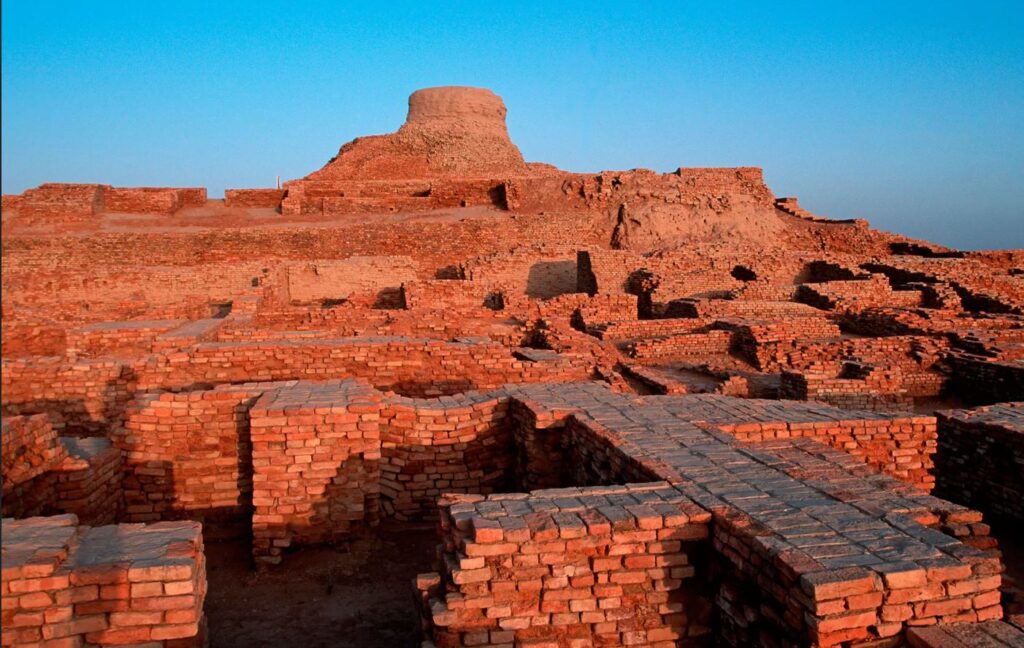
The fact remains that the political organization of the Indus cities escapes the experts. Because contrary to the Mesopotamian and Egyptian civilizations, the researches realized on the sites of the valley of the Indus did not bring to light any temple or palace of scale. There is no proof either of the existence of a permanent army…
Of what to wonder about the presence or not of a political power. Panic among British archaeologists and geopoliticians always inclined to project their own colonial ideology of aristocratic castes on the rest of the world.
In reality, each city seems to have had its own governor, or citizen council coordinating with other urban areas, all adhering to a number of common principles considered mutually beneficial.
This “Coincidence of Opposites”, of great diversity with perfect similarity, intrigues expert John Keay:
What amazed all those pioneers, and what remains the distinguishing characteristic of the several hundred Harappan sites now known, is their apparent similarity: ‘Our overriding impression is of cultural uniformity, both throughout the several centuries during which Harappan civilization flourished, and over the vast area it occupied.’ The ubiquitous bricks, for example, all have standardized dimensions, just as the stone cubes used by the Harappans to measure weight are also standardized and based on the modular system. The width of roads conforms to a similar module; thus, streets are generally twice as wide as side streets, while main arteries are two or one and a half times as wide as streets. Most of the streets excavated so far are straight and run north to south or east to west. The city plans thus conform to a regular grid pattern and seem to have retained this arrangement through several phases of construction.
Hence, given the existence of a unified system of weights and measures; given the similarity of urban organization as well as the standardization of the size of terracotta bricks for hundreds of cities, it is therefore simply impossible that the every man for himself reigned supreme.
Cradle of democracy?
In 1993, in an article entitled « The Indus Valley Civilization, Cradle of Democracy? », published by the UNESCO Courier, the internationally renowned Pakistani archaeologist and museologist, Syed A. Naqv, who has been fighting for the preservation of the Mohenjo-daro site, attempted to answer the question.
In all the highly developed civilizations of the past – Mesopotamia, the Nile Valley, Anatolia, China – the pervasive influence of an imperial authority can be felt, providing patronage for the arts and directing the evolution of society. A close examination of such an imperial authority over this civilization, which flourished some 5,000 years ago and covered almost twice the area of the civilizations of Mesopotamia and the Nile combined seems to belie the presence of an authoritarian regime, the Indus civilization had a well-disciplined way of life, civic controls and organizational system which could only have stemmed from the kind of “rule by the people” that was exercised in some Greek city-State some 2,000 years later. Did Greece give birth to democracy, or did Greece simply follow a practice developed earlier?
Although there are no large structures acting as centers of authority,
the discoveries made so far suggest that the rule of law extended over an area measuring roughly 1,600 kilometers from the north to the south and more that 800 kilometers from east to west. The main argument in support of this thesis is the existence of well-established norms and standards which would have required the consensus of the people if they had not been imposed by an authoritarian regime. It is impossible to ignore the evidence furnished by the perfect planning of the great city of Mohenjo-daro and the use in its construction of standard-sized bricks 27.94 cm long, 13.96 cm wide and 5.71 cm thick.
In the two large cities of Mohenjo-daro and Harappa, about 600 km distant,
the grid pattern of the street layout uncovered by the archaeological excavations shows that great attention was paid to the security of the inhabitants and suggests the existence of a highly developed and well-monolithic system of civic control.
The same is true of the highly sophisticated sewage system and the existence of
a virtually complete series of highly polished stone weights. Their shapes are cubical, half-cubical, cylindrical and spherical, and very few of them are reported to be defective. They provide yet another proof of a civic authority maintaining consistent commercial standards.
It is not possible to conclude that such « a philosophical conception of democracy exists until the Harappan script is deciphered and written evidence is provided. But the signs are there, and further research in this direction may well establish that ‘government by the people’ originated in the Indus Valley, » the author concludes.
Finally, since this agricultural people, who knew the use of the spears and the arrows but didn’t leave any trace of a major military activity – few weapons nor fortifications with exclusively defensive purpose have been found – , many observers agree to say that this society could have known the longest period of peace of the history of the humanity.
Decay and fall
In two of his books, the Timaeus and the Critias, the Greek philosopher Plato tells the story « certainly true, although strange » of a maritime people with incomparable power: the Atlantes whose civilization and capital he describes in great detail.
Starting 10,000 years before our era from an island located beyond the columns of Hercules, the Atlanteans would have ended up dominating the whole of Africa and Western Europe.
In a passage which is not without recalling the type of political organization which could exist in Mohenjo-daro, Critias specifies that Atlantis was then inhabited « by the various classes of men who deal with the trades and agriculture. The warriors, separated from the beginning by divine men, lived separately, possessing all that was necessary for their existence and that of their children. Among them, there were no particular fortunes; all goods were in common: they demanded from the other citizens nothing beyond what they needed to live, and fulfilled in return all the obligations that our talk of yesterday attributed to the defenders of the fatherland as we conceive them. »
Perhaps speaking metaphorically, Plato states that initially virtuous, the Atlantis civilization would have sunk into excess, arrogance and corruption to the point of being chastised by Poseidon himself for having embarked on one war too many, this time against Athens. And « in the time lapse of a single terrible day and night (…) the island of Atlantis sank into the sea and disappeared ».
At the historical level, the sudden decline of the Indus civilization around 1900 BC remains a mystery. Historians point to aspects of Minoan civilization (Crete) showing astonishing similarities with the IVC, especially watermanagement and early sewer systems in Knossos, lost wax broze casting techniques and bull fighting.
A few traces of fire and destruction, as well as forty skeletons wounded with knives and found without burial at Morenjo-daro, first suggested an invasion by Aryan peoples from Central Asia or the Iranian plateau. « This theory has now been abandoned. We have indeed found no effective trace of massacres or violence on the sites of the Indus Valley, or furniture that could be associated with such populations, » says Aurore Didier, researcher at the CNRS and director of the Indus mission.
Another hypothesis, an inability to strengthen its resilience to climatic chaos. « The samples taken in the northwest of India have shown that the climate there has changed significantly about 2000 years before our era. It is reported that this was also the case in Mesopotamia. « It became more like the dry and arid climate of today, which disrupted the cultivation and, in fact, the trade of the Indus civilizations. The ensuing socio-economic upheaval may have led to the decline of these societies. This hypothesis is the most commonly accepted to date, » says the archaeologist.
The inhabitants would have left their valleys become infertile to migrate to the plains of the Ganges. « This was accompanied by a change in livelihood strategies. The Indus civilization gradually converted to summer cereal crops based on rice and millet, two commodities more able to withstand these new climatic conditions and requiring, for rice, the development of irrigated agriculture, » says Aurore Didier. « It has also forged links with new trading partners.”
So there is no reason to talk about the « collapse » of a society in the sense of collapsologists. It is rather a gradual adaptation to the evolution of the environment, spread over several centuries.
As the excavations of the sites of the Indus Valley civilization continue, new information will undoubtedly contribute to a better understanding of its history and development. Any additional knowledge of this common civilizational legacy will serve in the future as a basis for fraternal cooperation between Pakistan, India and Afghanistan and others.
In the meantime, instead of trying to copy the barbaric « models » of the Mongolian Empire, the Roman Empire or the British Empire, the « elites » of the transatlantic world would do better to draw inspiration from a magnificent civilization that seems to have prospered for 5,000 years without perpetual wars and massacres, but simply thanks to a good mutual understanding, at the national level, between citizens, and thanks to mutually beneficial cooperation with the overriding majority of its distant partners.
The Indus Valley Civilization’s modernity, capable of offering food, shelter, water and sanitation to all, in a mirror image, shows all of us living in the present, how backwards we became.
Posted in Comprendre, Etudes Renaissance | Commentaires fermés sur The challenging modernity of the Indus Valley Civilization
Tags: Afghanistan, archaeology, artkarel, Baluchistan, bathing, beer, Bhirrana, breweries, bricks, British Museum, Buddhist, camel, canals, cereals, Chalcolithic, China, copper, cotton, Cotton Roads, Dancing girl, Danny Rosenberg, dates, dentistry, dessin, Dolavira, Dravidians, Egypt, fibers, gold, granaries, Gujarat, Harappa, husbandry, India, Indus, irrigation, Israel, IVC, Kalibangan, Karel, Karel Vereycken, Khambhat, lapis, latrines, livestock, Lothal, Mehrgahr, Mehrgahr amulet, Mes Aynak, Mesopotamia, Mohenjo-daro, mother goddess, mustard, navigation, NIOT, Oman, Pakistan, peas, Persia, port, Priest King, Rakhigari, renaissance, reservoir, Romorantin, sanitation, Sarasvati, sewers, silver, Suktagan Dor, Surkotoda, Tel Tsaf, toilets, toys, Valley, Vereycken, water, wells
Posted by: Karel Vereycken | on juin 21, 2021
Mutazilism and Arab astronomy, two bright stars in our firmament

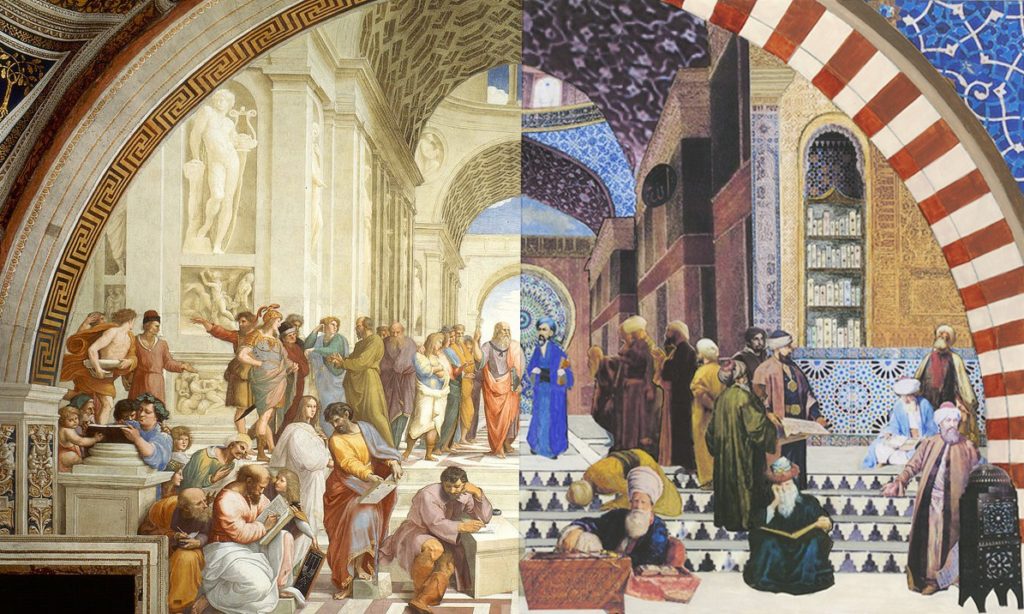
By Karel Vereycken
(texte original en français)
“The ink of the scholar is holier than the blood of the martyr.”
Sayings (Hadith) most often attributed to the Prophet.
“Seek knowledge from the Cradle to the Grave.”
“Seek knowledge even as far as China.”
PROLOGUE
We live in a time of cruel stupidity. While the history of civilization is characterized by multiple cultural contributions allowing an infinite and magnificent mutual enrichment, everything is done to dehumanize us.
By dint of media coverage of the most extreme crimes, notably by claiming that such and such an abject or barbaric act has been committed « in the name » of such and such a belief or religion, everything is done to set us against each other. If we do not react, the famous thesis of a « Clash of Civilizations », concocted by the British Islamologist Bernard Lewis (Henry Kissinger’s, Zbigniew Brzezinski’s and Samuel Huntington’s mentor) as an evil tool of geopolitical manipulation, will become a self-fulfilling prophecy.
INTRODUCTION
In order to combat prejudices and dangerous misunderstandings about “Islam” (with 1.6 billion believers a non-negligible part of the world’s population), here follows a brief overview of the major contributions of the Arab-Muslim civilization.
By recalling two major contributions of the “Golden Age” of Islam, notably Arab astronomy and mutazilism, what is at stake here is the recognition that –just like Memphis, Thebes, Alexandria, Athens and Rome– Baghdad, Damascus and Cordoba were major crucibles of a universal civilization which is ours today.
While Europe has come to recognize that the invention of printing took place in China long before Gutenberg, and that America was visited way before Christopher Columbus, consensus and group think keeps repeating that the Arabs contributed nothing to the progress of science.
In the 1300 years separating the Greek astronomer from Alexandria, Claudius Ptolemy (ca. 100-178 AD) from the Polish Nicolaus Copernicus (1473-1543), they pretend, nothing but “a black hole”.
In 1958, in his book The Sleepwalkers, British Hungarian writer Alfred Koestler, who helped Sydney Hook to co-found the CIA’s cultural cold war front, the Congress for Cultural Freedom, epitomized western arrogance, writing:
the Arabs had merely been the go-betweens, preservers and transmitters of the heritage. They had little scientific originality and creativeness of their own. During the centuries when they were the sole keepers of the treasure, they did little to put it to use. (…) and by the fifteenth century, the scientific heritage of Islam had largely been taken over by the Portuguese Jews. But the Jews, too, were no more than go-betweens, a branch of the devious Gulf-stream which brought back to Europe its Greek and Alexandrine heritage, enriched by Indian and Persian additions.
Nothing is more false. Definitely, one must be born on the right spot to be allowed to have a seat in the train of history…
Copernicus himself, unlike Koestler, was perfectly familiar with Arab astronomy. In 1543, in his De Revolutionibus, he quotes several Arab scientists, more precisely Al-Battani, al-Bitruji, al-Zarqallu, Ibn Rushd (Averroes) and Thabit ibn Qurra. Copernicus also refers to al-Battani in his Commentariolus, a manuscript published posthumously. Later, the great Johannes Kepler (1571-1630) would also refer to Ibn Al-Haytam in his work on optics.
In reality, Copernicus and even more Kepler, whose creative genius cannot be overrated, came up with answers to questions raised by several generations of Arab astronomers preceding them and whose contribution remains largely ignored and even worse, unexplored. To this day, with about 10,000 manuscripts preserved throughout the world, a large part of which has still not been the subject of a bibliographic inventory, the Arab astronomical corpus constitutes one of the best preserved components of medieval scientific literature waiting to be rediscovered.
Science and religion versus slavery
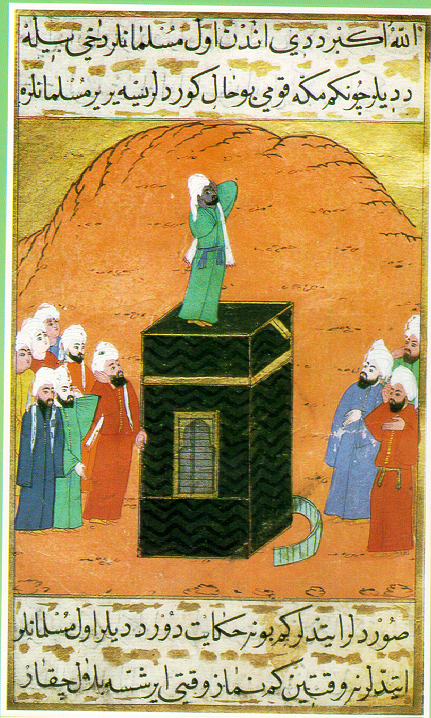
Before examining the contributions of Arab astronomy, a few words about the intimate link between Islam and the development of science.
According to tradition, it was in 622 AD that the Prophet Muhammad and his companions left Mecca and set out for a simple oasis that would become the city of Medina.
If this event is known as the “Hegira”, an Arabic word for emigration, break-up or exile, it is also because Mohammad broke with a societal model based on blood ties (clan organization), in favor of a model of a shared destiny based on belief. In this new religious and societal model, where each person is supposed to be a “brother,” it is no longer permissible to abandon the poor or the weak as was the case before.
The powerful clans in Mecca did everything they could to eliminate this new form of society, which diminished their influence.
The “Medina Constitution” allegedly proclaimed equality among all believers, whether they were free men or slaves, Arabs or non-Arabs.
The Koran advocates strict equality between Arabs and non-Arabs in accordance with the Prophet, who said, in his farewell address:
“There is no superiority of an Arab over a non-Arab, or of a non-Arab over an Arab, and no superiority of a white person over a black person or of a black person over a white person, except on the basis of personal piety and righteousness.”
(Reported by Al-Bayhaqi and authenticated by Shaykh Albani in Silsila Sahiha no. 2700).
Hence, if after the Prophet’s passing away, slavery and slave trade became a common practice in close to all Muslim countries, he cannot be held accountable. Zayd Ibn Harithah, according to tradition, after having been the slave of Khadija, Muhammad’s wife, was freed and even adopted by Muhammad as his own son.
For his part, Abu Bakr, Muhammad’s companion and successor as the first Caliph (Arab word for “successor”), also freed Bilal ibn-Raba, the son of a former Abyssinian princess who had been enslaved. Bilal, who had a magnificent voice, was even appointed the first muezzin, that is to say the one who calls for prayer five times a day from the top of one of the mosque’s minarets.

Among the first verses revealed to the Prophet Muhammad one finds :
“Read! And your Lord is the Most Generous,
(Surat 96).
Who taught by the pen — Taught man that which he knew not.”
The Prophet also states,
“The best among you (Muslims) are those who learn the Koran and teach it.”
Other sayings, often attributed to the Prophet, clearly invite Muslims to seek knowledge and cherish science :
“The ink of the scholar is more sacred than the blood of the martyr”.
“Seek knowledge from the Cradle to the Grave”.
“Seek knowledge even as far as China”.
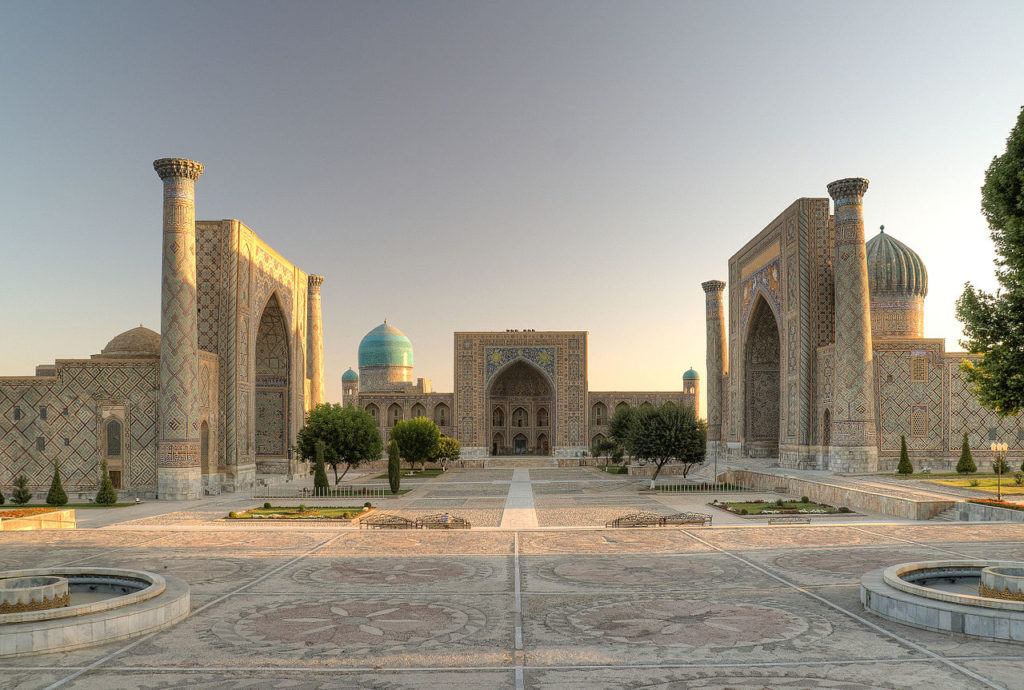

The mosque is therefore much more than a place of worship, it is a school of all sciences, where scholars are trained. It serves as a social and educational institution: it may be completed with a madrassa (Koranic school), a library, a training center, or even a university.
As in most religions, in Islam, practices and rituals are punctuated by astronomical events (years, seasons, months, days, hours). Every worshipper must pray five times a day at times that vary depending on where he or she is on Earth: at sunrise (Ajr), when the sun is at its zenith (Dhohr), in the afternoon (Asr), at sunset (Magrib) and at the beginning of the night (Icha). Astronomy, as a spiritual occasion to fine-tune one’s earthly existence according to the harmony of the Heavens, is omnipresent.
As an example, to underscore its importance, July 16, 622 AD, the first day of the lunar year, was declared the first day of the Hegira calendar. And during the eclipse of the sun, mosques host a special prayer.
Islam encourages Muslims to guide themselves by the stars. The Koran states :
“And He is the One who made the stars for you
to guide you with them in darkness of the land and the sea”.
With such an incentive, early Muslims could not but feel compelled to perfect astronomical and navigational instruments. As a result, today more than half of the stars used for navigation bear Arabic names. It was only natural that the faithful constantly tried to improve astronomical calculations and observations.
The first reason to do so is that during the Muslim prayer, the worshipper has to prostrate himself in the direction of the Kaaba in Mecca, so he has to know how to find this direction wherever he is on Earth. And the construction of a mosque will be decided according to the same data.
The second reason is the Muslim calendar. The Koran states :
“The number of months in the sight of Allah is twelve (in a year)-
so ordained by Him the day He created the heavens and the earth;
of them four are sacred: that is the straight usage.”
Clearly, the Muslim calendar is based on the lunar months, which are approximately 29.5 days long. But 12 times 29.5 days is only 345 days in the year. This is far from the 365 days, 6 hours, 9 minutes and 4 seconds that measure the duration of the rotation of the Earth around the Sun…
Finally, a last challenge was posed by the interpretation of the lunar movement. The months, in the Muslim religion, do not begin with the astronomical new moon, defined as the moment when the moon has the same ecliptic longitude as the sun (it is therefore invisible, drowned in the solar albedo); the months begin when the lunar crescent starts to appear at dusk.
The Koran says: “(Muhammad), they ask you about the different phases of the moon. Tell them that they are there to indicate to people the phases of time and the pilgrimage season.”
For all these reasons, the Muslims could not be satisfied with either the Christian or the Hebrew calendar, and had to create a new one.
Spherical geometry
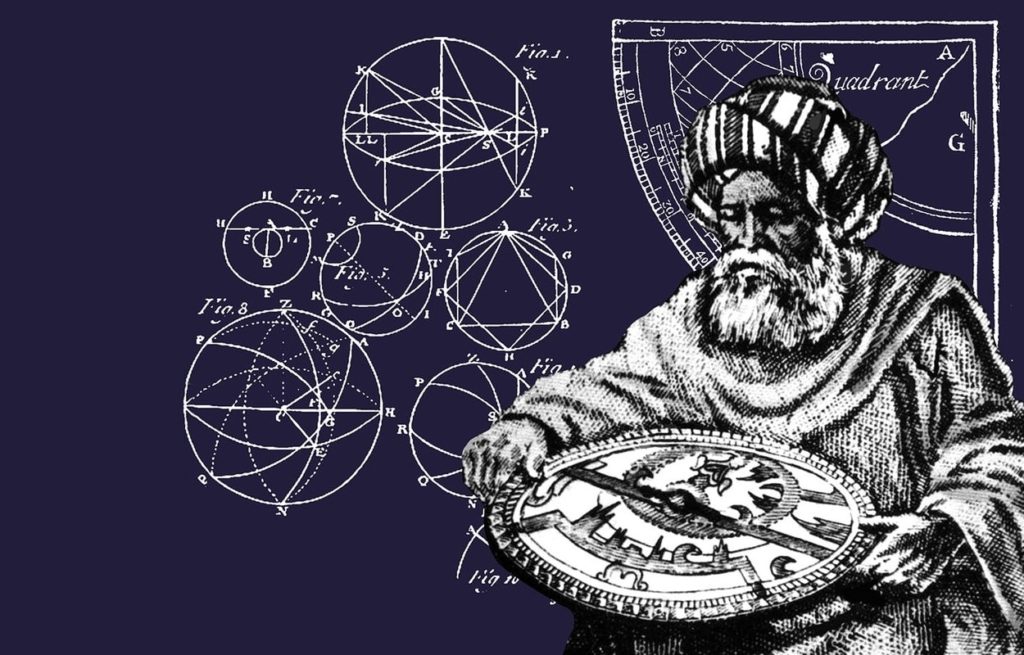
In order to forecast the phases of the moon, new methods of calculation and new instruments capable of observing them were required. The calculation of the day when the crescent moon starts to become visible again was a formidable challenge for the Arab scholars. To predict this day, it was necessary to be able to describe its movement in relation to the horizon, a problem whose resolution belongs to a rather sophisticated spherical geometry.
It was the determination of the direction of Mecca from a given location and the time of prayers that led the Muslims to develop such geometry. To solve these problems, it is necessary to know how to calculate the side of a spherical triangle of the celestial sphere from its three angles and the other two sides; to find the exact time, for example, it is necessary to know how to construct the triangle whose vertices are the zenith, the north pole, and the position of the Sun.
The field of astronomy has strongly stimulated the birth of other sciences, in particular geometry, mathematics, geography and cartography. Some people like to recall that Platonists and Aristotelians were arguing about rather abstract concepts, each of them believing that reason was sufficient to understand nature. Arab astronomy, on the other hand, played a decisive role in the emergence of a true scientific method by verifying the various hypotheses, by building measuring instruments and astronomical observatories and by rigorously recording observations over many years.
MUTAZILISM
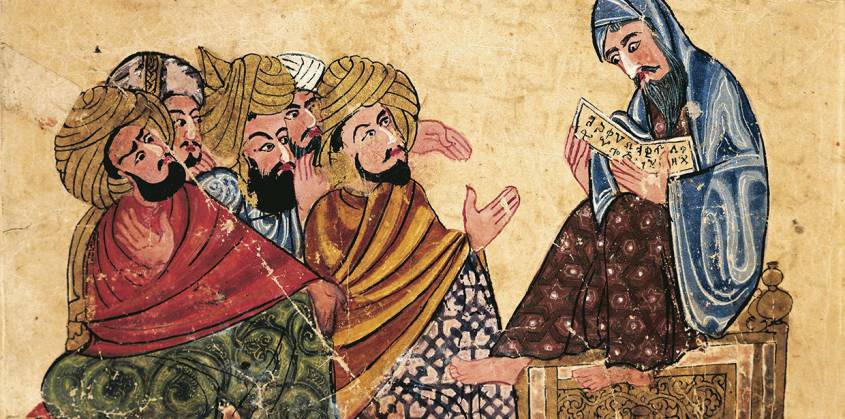
Arabic miniature from a manuscript, Turkey 13th Century.
The question then arises as to where this infatuation with science and astronomy could have come from, in a culture essentially centered on religion?
A first answer comes from the fact that in the 8th century, shortly after the birth of Sunnism (656), Kharidjism (657) and Shi’ism (660), but independently of these currents, a school of Muslim theological and philosophical thought appeared, founded by the revolutionary theologian Wasil ibn Ata (700-748), a current known as “mutazilism” (or motazilism), branded in the West as “the rationalists” of Islam. One explanation of its name came from the fact that the mutazili refused to take part in the internal strife inside factions using theological interpretations for earthly power, the arab word iʿtazala meaning “to withdraw”.
Wasil was born in Medina in the Arabian Peninsula and moved to Basra, now in Iraq. From there he formed an intellectual movement that spread all over the Arab-Muslim world. Many of his followers were merchants and non-Arabs (mawâlî) from Iranian or Aramaic “converted” families, victims of the Omayyad dynasty’s discriminating policies between Arabs and non-Arabs. This hypothesis is sufficient to back the claim of a Mutazilite participation in the overthrow of the Omayyad and that dynasty’s replacement with the Abbasid.
In a clear break with dualistic cosmology (Mazdeism, Zoroastrianism, Manichaeism, etc.), Mutazilism insists on the absolute unity of God, conceived as an entity outside time and space. For them, there is a close relationship between the unity of the Muslim community (Ummah) and the worship of the Lord. The Mutazilites are closely inspired by the Koran, and it is quite wrong to present them as the “free thinkers” of Islam.
However, “we reject faith as the only way to religion if it rejects reason,” the Mutazilite saying goes. Relying on reason (the logos dear to the Greek thinkers Socrates and Plato), which it considers compatible with Islamic doctrines, Mutazilism affirms that man can, outside of any divine revelation, access knowledge.
Just as Augustine, a christian, emphasized man can advance on the path of truth, not only through the Gospel (revelation), but by reading “the Book of Nature”, a reflection and foretaste of divine wisdom. One book of the Bible, The Book of Wisdom, recognizes that
For from the greatness and the beauty of created things
(Book of Wisdom, 13:5)
their original author,
by analogy, is seen.
The Mutazilites differed from their opponents in their teaching that God has endowed man with reason specifically so that he can come to know the moral order in creation and its Creator; that is what reason is for. Reason is central to man’s relationship to God.
In the Fundamentals, the great Mutazilite theologian Abdel al Jabbar Ibn Ahmad (935-1025), whose texts were discovered only in the 1950’s by Egyptian scholars in a mosque in Yemen, begins by positing the primary duty to reason: « If it is asked: What is the first duty that God imposes you? Say to him: Speculative reasoning which leads to knowledge of God, because He is not known intuitively or by the senses. Thus, He must be known by reflection and speculation ».
Therefore, Reason logically precedes revelation. Reason first needs to establish the existence of God before undertaking the question as to whether God has spoken to man. Natural theology mus be antecedent to theology.
Al Jabbar says: « The stipulates of revelation concerning what we should say and do are no good until after there is knowledge of God, » which knowledge comes from reason. « Therefore, » he concludes, « it is incumbent on me to establish His existence and to know Him so that I can worship Him, give Him thanks and do what satisfies Him and avoid disobedience toward Him ».
How does Reason lead man to the conclusion of God’s existance? It is through the observation of the ordered universe that man first comes to know that God exists, says Al Jabbar. As he sees hat nothing in the world is its own cause, but is caused by something else, man arrives at the contingent nature of creation. From there, man reasons to the necessity of a Creator, an uncaused cause.
The concept of an inherent nature in things (tab’) means that God, though he is the First Cause, acts indirectly through secondary causes, such as the physical law of gravity. In other words, God does not immediately or directly do everything. He does not make a rock fall; gravity does. God allows some autonomy in his creation, which has its own set of rules, according to how it was made.
As Mutazilite writer and theologian Uthman al-Jahiz (765-869) stated, every material element has it own nature. God created each thing with a nature according to which it consistently behaves. The unsupported rock will always fall where there is gravitational pull. These laws of nature, then, are not an imposition of order from without by a commander-in-chief, but an expression of it from within the very essence of things, which have their own integrity. Creation is possessed of an intrinsic rationality from the Creator. That is why and how man is able to understand God’s Reason as manifested in his creation (This does not discount God’s ability to supercede natural laws in the case of a miracle). From that standpoint, the act of discovery of the nature and beauty of things, by each human individual, brings him closer to God.
Hence, Muzatilism gives human reason (the faculty of thinking) and freedom (the faculty of acting) a place and importance not only unknown in other trends of Islam but even in most philosophical and religious currents of the time. Against fatalism (“mektoub!” = it was written!), which was the dominant tendency in Islam, mutazilism affirms that the human being is responsible for his acts.
More than five centuries before Erasmus, Mutazilite faith and philosophy offered already the foundations to solve most of the sterile theological disputes that would destroy the Renaissance and throw Europe in the abyss of self-destruction known as the “wars of religion”.
Here are the five Fundamentals (Principles), described by Abdel al Jabbar and summarized in 2015 by economist Nadim Michel Kalife:
—Monotheism (Al Tawhid) whose concept of God is beyond the simple intellect of the human mind. That is why the verses of the Koran describing God “sitting” on a throne should be interpreted only allegorically and not literally. Hence the Mutazilites called their opponents anthropomorphists who sought to reduce God who is unknowable to a human appearance. And they concluded that this one detail (!) of the Koran is sufficient to prove that the Koran is not “uncreated” but “created” by Allah, via man, to make it accessible to the believer, and therefore, that it can and should evolve and adapt according to the times and circumstances ;
—Divine justice (Adl) is about the origin of evil in our world where God is all-powerful. Mutazilism proclaims free will, where evil is man’s doing and not God’s will, because God is perfect and therefore cannot do evil or determine man to do it. And, if human wrongdoings were the will of God, punishment would lose all meaning since man would be doing nothing but respecting the divine will. This unquestionable logic allowed Mutazilism to refute predestination and the « mektoub » of the Sunni schools;
—Promise and threat (al-Wa’d wa al-Wa’id): this principle concerns the judgment of man at his death and that of the last judgment where God will reward the obedient in the heavenly paradise, and punish those who disobeyed him by damning them eternally in the fires of hell;
—The intermediate degree (al-manzilatu bayn al-manzilatayn), the first principle opposing Mutazilism to the Sunni schools. A great sinner (murder, theft, fornication, false accusation of fornication, drinking alcohol, etc. ) should be judged neither as a Muslim (as Sunnism thinks) nor as a disbeliever or kâfir (as the Kharidjites think), but considered in an intermediate degree from which, when he dies, he will go to hell if he failed to be redeemed by God’s mercy ;
—To order the good and blame the blameworthy (al-amr bil ma’ruf wa al-nahy ‘an al munkar): this principle authorizes even rebellion against authority when it is unjust and illegitimate, to prevent the victory of evil over all. This principle attracted the hatred of the ulama (theologians) and imams (predicators) who saw it as a manouver to weaken their own authority over the faithful. And the Seljuk Turks considered it a serious danger since it called into question their power… over the Arabs.
Mutazilism under the Abbasid
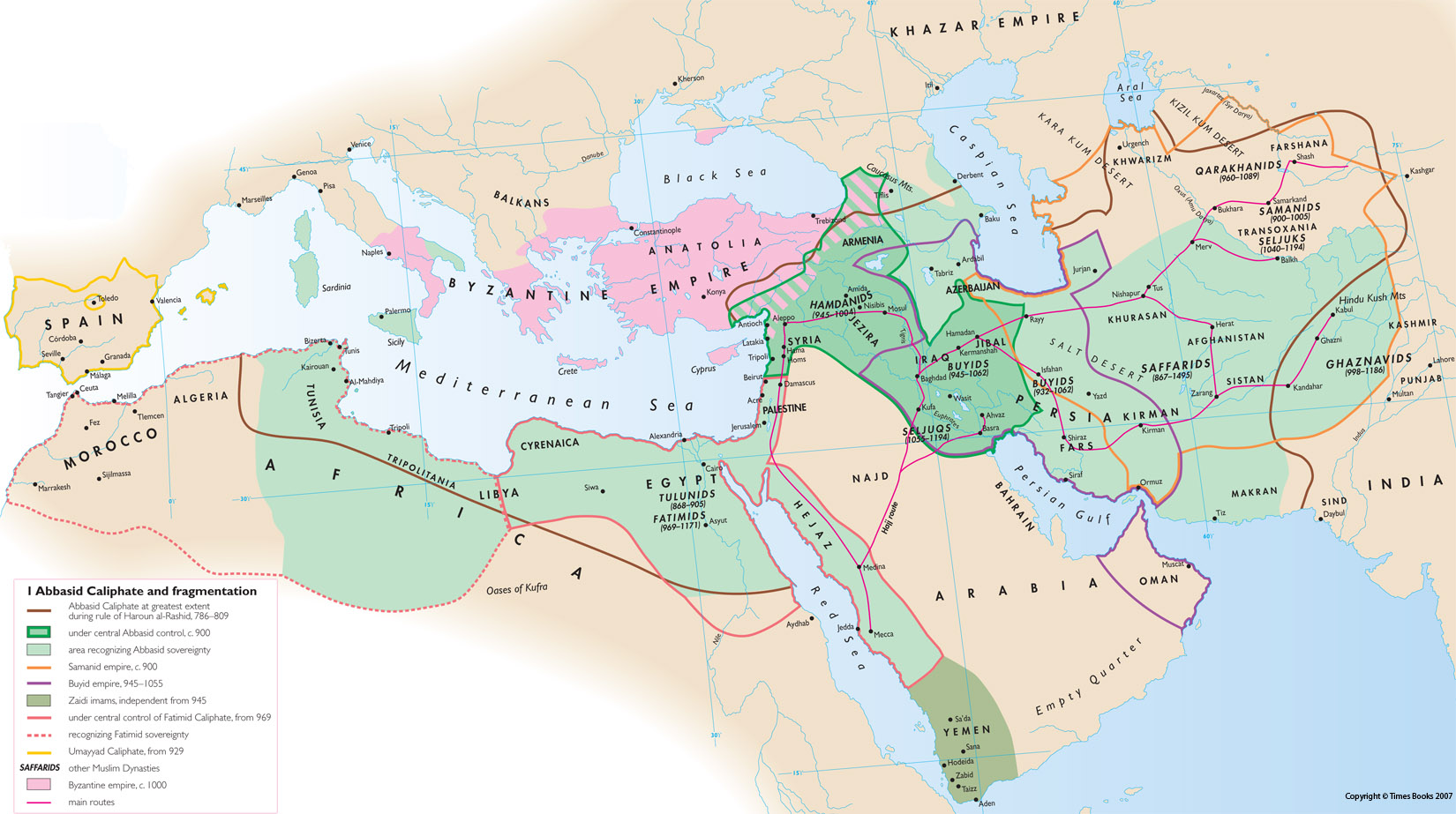

In Baghdad, it was with the rise of the Abbasid Caliphate in 749 that Mutazilism gained influence, first under the Caliph Hâroun al-Rachîd (765-809) (“Aaron the Well-Guided”) and then under his son, Al-Ma’mûn (786-833) (“The one to be trusted”). Shortly before his death in 833, the latter made Mutazilism the official doctrine of the Abbasid Empire.
This was too much for the conservative ulama and imams who rebelled against the Caliph’s enlightened vision that created a space for secular society and limited their grip over society. Faced with the revolt, the Abbasid administration (made up largely of Persians), which was won over to Mutazilism, carried out a ruthless crackdown on Sunni (Arab) clerics for fifteen years, from 833 to 848. This bloody persecution left an increasingly bitter taste in people’s minds, especially when the Abbasid power refused to release Muslim prisoners in the hands of the Byzantines if they did not renounce the dogma of the “uncreated” nature of the Koran…
Finally, in 848, Caliph Jafar al-Mutawakkil (847-861), changed course completely and asked the traditionalists to preach hadiths according to which Muhammad had condemned the Mutazilites and their supporters.
Dialectical theology (Kalâm) was banned and the Mutazilites were not any longer welcome at the Baghdad court. This was also the end of the spirit of tolerance and the return of persecution against Christians and Jews. If the craze for science continued, Mutazilism disappeared with the fall of the Abbasids and the destruction of Baghdad by the Mongols in the 13th century.
Mutazilism also influenced Judaism. The Kitab Al-Amanat Wa’l-I’tiqadat – that is, the Book of Beliefs and Opinions – by the tenth-century Jewish rabbinic scholar Saadia Gaon (882-942), who lived in Baghdad, draws its inspiration from Christian theological literature as well as from Islamic models. The Kitab al-Tawhid, the Book of Divine Unity, by Saadia’s Karaite contemporary, Jacob Qirqisani (d. 930), is unfortunately lost.
This makes the German Islamologist Sabine Schmidtke say:
The new tradition of Jewish rational thought that emerged in the course of the ninth century was, in its initial phase, mainly informed by Christian theological literature, both in its content and methodology. Increasingly, specifically Mutazilite Islamic ideas, such as theodicy [*1] and human free will, as well as the emphasis on the oneness of God (tawhid), resonated among Jewish thinkers, many of whom eventually adopted the entire doctrinal system of the Mutazila. The now emerging ‘Jewish Mutazila’ dominated Jewish theological thought for centuries to come.
Brothers in Purity

Also worth mentioning in this context, are the Epistles of the Brothers in Purity (Ikwân al-Safâ), an encyclopedia of 52 epistles (dealing with mathematics, natural sciences, rational sciences and theological sciences), composed between the beginning of the ninth and the end of the tenth century and containing common knowledge. The text will be promoted by the Ismailis, an esoteric branch of shiite islam strongly contesting the ruling powers of that time. Produced in Basra, in present-day Iraq, the book, neo-platonic in character, is a collective work. As for the authors, designated under the mysterious name of Brothers of Purity, they belonged to a brotherhood of sages and intellectuals who met regularly to organize sessions of discussion, readings and recitation. Its followers considered that knowledge was an indispensable condition for any spiritual and mystical elevation. Its avant-garde character is apparent in its hymn to tolerance advocating a plurality of paths to salvation. Some experts believe that the Epistles of the Brothers in Purity are the work of a high-level Pythagorean philosopher, a disciple of the mutazilist platonic, al-Kindi.
Leaving aside, therefore, the errors that were very real, it has to be recognized and underscored that the optimistic philosophical vision of Mutazilism (reason, free will, responsibility, perfectibility of man) strongly contributed to the emergence of a true « golden age » of Arab culture and sciences.

Finally, it is not uninteresting to note that today, “neo-Mutazilite” currents are appearing in reaction to obscurantist doctrines and the barbaric acts they provoke. For the Egyptian reformist thinker Ahmad Amin, “the death of mutazilism was the greatest misfortune that befell Muslims; they committed a crime against themselves.”
Bagdad
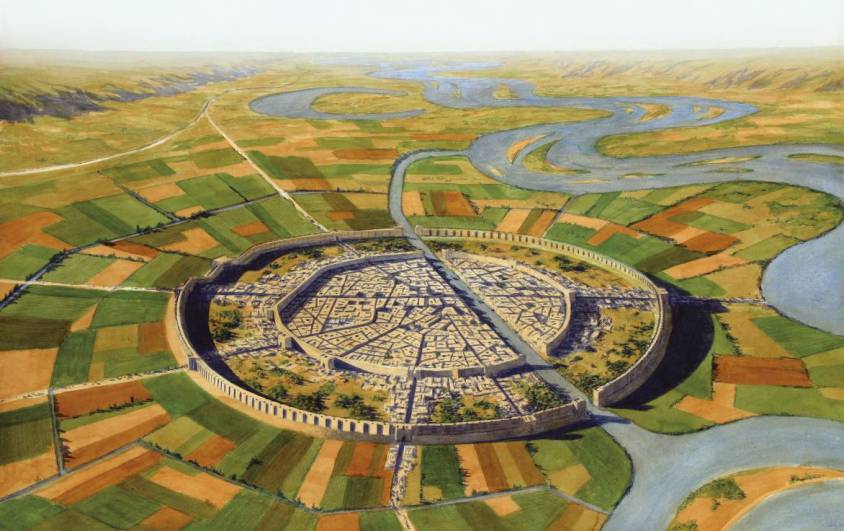
In 762, the second Abbasid caliph Al-Mansur (714-775) (“the victorious”) began construction of a new capital, Baghdad. Called Madinat-As-Salam (City of Peace), it houses the court palace, the mosque and the administrative buildings. Built on a circular plan, it is inspired by previous traditions, notably the one that gave birth to the Iranian city of Gur (current name: Firouzabad).
We are in the heart of fertile Mesopotamia, the “land between the rivers”, essentially the Euphrates and the Tigris, both of which have their source in Turkey. It is here that the Sumerians invented irrigation, agriculture (cereals and livestock) [*2], and writing (3400 years BC), starting in the 10th millennium BC.
Baghdad, a powerful and refined city, reigned over the entire East and became the capital of the Arab world. Crossed by the Tigris River, populated today by some 10 million inhabitants, it remains the largest city in Iraq as well as the second most populated city in the Arab world (behind Cairo in Egypt).
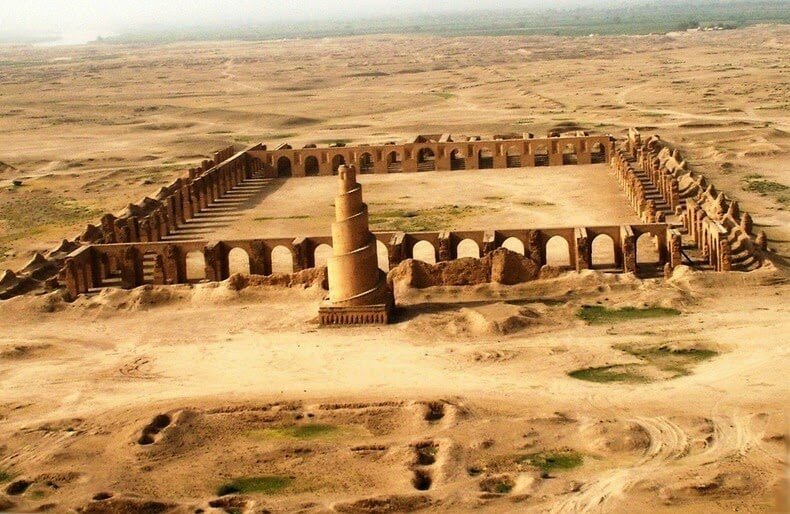
The Abbasid cities were built on huge sites. The palaces and mosques of Samarra, the new capital from 836, stretch along the banks of the Tigris for 40 kilometers. To match the scale of the sites, monumental buildings were erected, such as the Abu Dulaf Mosque or the Great Mosque of Samarra, which had no equivalent elsewhere. Its curious spiral minaret (52 meters high) inspired in the following centuries the Western representations of the Tower of Babel.
Moreover, by relying on an extremely disciplined and obedient army from Khorassan (a region in north-eastern Iran) [*3], as well as on an elaborate system of stagecoaches and mail distribution, the Abbasid rulers managed to increase their hold on the provincial governors. The latter, who in the time of the Omayyad caliphs paid little tax on the pretext that they had to spend locally for the defense of the caliphate’s borders, now had to pay the taxes imposed by the ruler.
The New “Paper” Road

After the military victory against the Chinese in the battle of Talas (a city in present-day Kyrgyzstan) in 751, the year that marked the most eastern advance of the Abbasid armies, Baghdad opened up to Chinese and Indian cultures.
The Abbasid quickly assimilated a number of Chinese techniques, in particular paper-making, an art developed in Samarkand (capital of Sogdiana, now in Uzbekistan), another stopover city on the Silk Roads. The craftsmen of this city smoothed the paper with an agate stone. The resulting extremely smooth and shiny surface absorbed less ink and as a result, both sides of the same sheet became usable. The Chinese, who had invented silk paper, did not need to smooth their paper because they wrote with brushes and not with pens.
Hâroun al-Rachîd was very interested in the industrial production of paper. He ordered the use of paper in all the administrations of the Empire: it is easier to manufacture, less expensive and more secure than silk, because one cannot easily erase what is written on it. He developed the paper factories of Samarkand and established similar ones in Baghdad, Damascus and Tiberias around 1046 – the paper of Tripoli or Damascus was then referred to, and its quality was considered better than that of Samarkand – in Cairo before 1199, where it was used as a packaging for goods, and in Yemen at the beginning of the 13th century. At the same time, several paper factories were established in North Africa. There were 104 paper factories in Fez, Morocco, before 1106, and 400 paper mills between 1221 and 1240. They will emerge in Andalusia, Spain, in Jativa near Valencia in 1054 and in Toledo in 1085.
Agro-industrial revolution

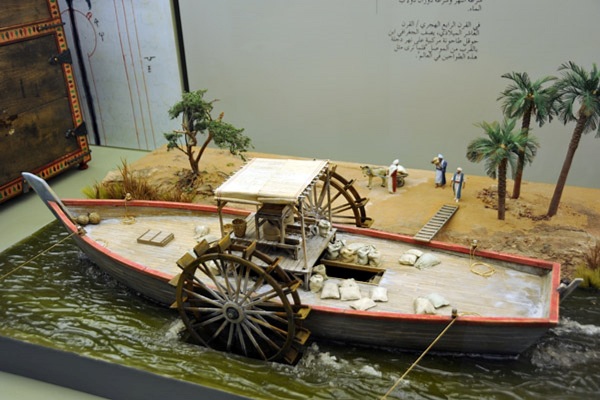
The first Abbasid caliphs led the economic transition from the Umayyad model of tribute, booty or the sale of slaves to an economy based on agriculture, manufacturing, trade and taxes. The introduction of more energy dense modes of technologies modes of energy (compared to the former ones), will revolutionize irrigation and agriculture:
–Construction of canals ensuring irrigation and limiting flooding;
–Construction of dams and the exploitation of the mechanical energy they produce;
–Construction of water mills;
–Use of tidal energy;
–Construction of windmills;
–Distillation of kerosene used as fuel for lamps and used since. [*4]
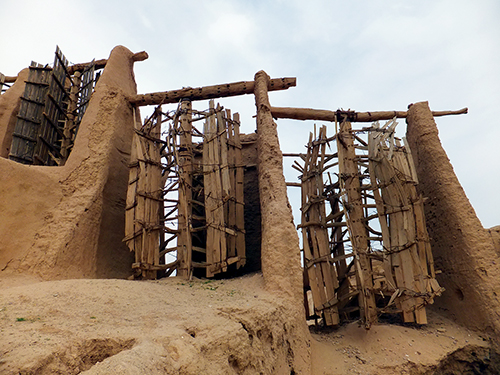
Industrial uses of water mills in the Islamic world date back to the 7th century. During the time of the Crusades, all provinces of the Islamic world had operating mills, from al-Andalus and North Africa to the Middle East and Central Asia.
These mills performed various agricultural and industrial tasks.
When Erasmus’ follower Cervantes’ Don Quichote starts attacking the windmills of La Mancha, a Spanish region where Arab influence was notable, he not only ironially mocks the cult of chivalry, but also the insane undertaking called the crusades.
Irrigation, inherited from the ancient world (floods of the Nile in Egypt, canals in Mesopotamia, pendulum wells (shadoof), water wheels used to raise water (noria), dams in Transoxiana, Khuzistan and Yemen, underground galleries at the foot of the mountains in Iran (qanat) or in the Maghreb (khettara), is organized thanks to a solid community organization and the intervention of the State.
Abbasid artisans and engineers will develop machines (such as pumps) incorporating crankshafts and use gears in mills and water-lifting machines. They will also use the dams to provide additional power to watermills and water-lifting machines. Such advances will allow the mechanization of many agricultural and industrial tasks and free up the workforce for more creative occupations.
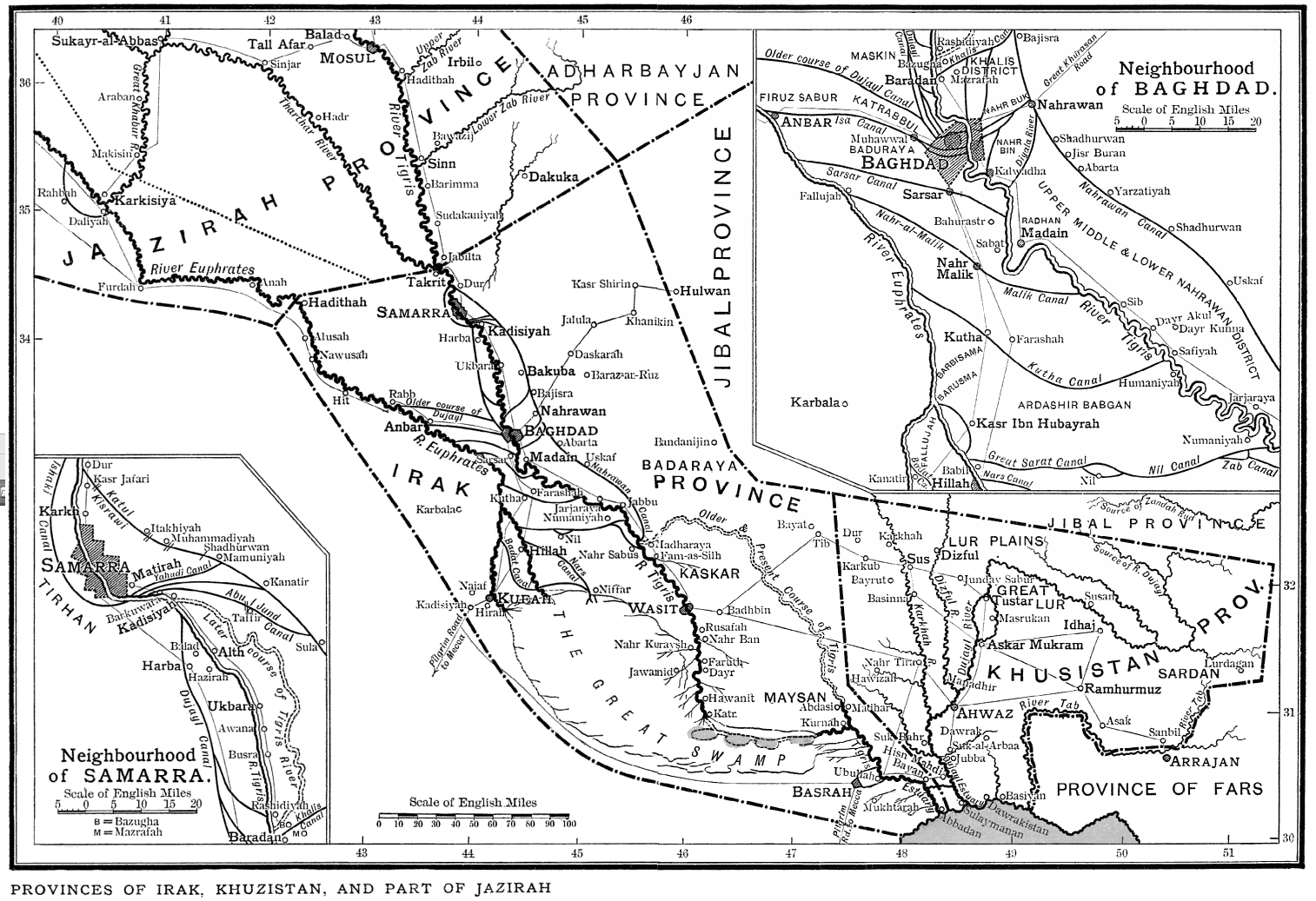
Agricultural production gains in diversity : cereals (wheat, rice), fruits (apricots, citrus fruits), vegetables, olive oil (Syria and Palestine), sesame (Iraq), roe, rapeseed, flax or castor oil (Egypt), wine production (Syria, Palestine, Egypt), dates, bananas (Egypt), sugar cane.
Breeding remains important for food, for the supply of raw materials (wool, leather) and for transport (camels, dromedaries, horses). Sheep are present everywhere but buffalo farming is developing (marshes of lower Iraq or Orontes). Small poultry, pigeon and bee farms are in high demand. The people’s diet is predominantly vegetarian (rice cake, wheat porridge, vegetables and fruits).
A number of industries will emerge from this agro-industrial revolution, including the first textile factories, the production of ropes, silk and, as noted above, the manufacture of paper. Finally, metalworking, glassware, ceramics, tooling and crafts also experience high levels of growth during this period.
Charlemagne, Baghdad and China

Finally, in the eighth and ninth centuries, seeking to counter the Omayyad and the Byzantine Empire, Abbasid and Carolingian Franks conclude several agreements and alliances.
Three diplomatic missions were sent by Charlemagne to the court of Hâroun al-Rachîd and the latter sent at least two embassies to Charlemagne. The caliph sent him many gifts, such as spices, fabrics, an elephant and an automatic clock, described in the Frankish Royal Annals of 807. It marked the 12 hours with copper balls falling on a plate at each hour, and also had twelve horsemen who appeared in turn at the same intervals.
The same caliph sent a diplomatic mission to Chang’an (now called Xi’an), capital of the Tang dynasty. Chang’an being the eastern terminus of the Silk Road, the western market of Chang’an became the center of world trade. According to the record of the Tang Six Authority, more than 300 nations and regions had trade relations with Chang’an.
Maritime Silk Road
These diplomatic relations with China were contemporary with the maritime expansion of the Muslim world into the Indian Ocean and the Far East. Apart from the Nile, Tigris and Euphrates, navigable rivers were uncommon, so transport by sea was very important. The ships of the caliphate began to sail from Siraf, the port of Basra, to India, the Straits of Malacca and Southeast Asia.
Arab merchants dominated trade in the Indian Ocean until the arrival of the Portuguese in the 16th century. Hormuz was an important center for this trade. There was also a dense network of trade routes in the Mediterranean, along which Muslim countries traded with each other and with European powers such as Venice or Genoa.
The Silk Road crossing Central Asia passed through the Abbasid caliphate between China and Europe. At that time, Canton, or Khanfu in Arabic, a port of 200,000 people in southern China, had a large community of traders from Muslim countries. And when the Chinese Emperor Yongle decided to send his famous flotilla of ships to Africa, he chose Admiral Zheng He (1371-1433), a court eunuch who was born a Muslim. And when in 1497 the Portuguese captain Vasco da Gama reached the Kenyan city of Malindi, he was able to obtain an Arab pilot who took him directly to Kozhikode (Calicut) in India. In short, a sailor who knew how to navigate on the stars.
Scientific and cultural renaissance

Thus, it is under the caliphate of Hâroun al-Rachîd and his son Al-Ma’mûn, that Baghdad and the Abbasids will experience a real golden age, both in the sciences (philosophy, astronomy, mathematics, medicine, etc.) and in the arts (architecture, poetry, music, painting, etc.). For the British writer Jim Al-Khalili, “the fusion of Greek rationalism and Mutazilite Islam will give rise to a humanist movement of a type that will hardly be seen before 15th century Italy.”
In the field of sciences, an assimilation of Hellenistic, Indian and Persian astronomical doctrines took place very early. Several Sanskrit [*5] and Pehlevi [*6] writings were translated into Arabic.
Indian works by the astronomer Aryabhata (476-560), a prominent scientist of the Indian Gupta Renaissance, and the mathematician Brahmagupta (590-668) were cited early on by their Arabic counterparts. A famous translation into Arabic appeared around 777 under the title Zij al-Sindhind (or Indian Astronomical Tables). Sources indicate that this text was translated after the trip of an Indian astronomer invited to the court of the Abbasid caliph Al-Mansur in 770. The Arabs also adopted the sines (inherited from Indian mathematics) which they preferred to the chords used by Greek astronomers. From the same period, a collection of astronomical chronicles compiled over two centuries in Sassanid Persia and known in Arabic as the Zij al-Shah (or Royal Tables).
In the field of music, the Persian-born Arab musician Ishaq al-Mawsili (767-850), among others, can be mentioned. A composer of about two hundred songs, he was also a virtuoso on the oud (a kind of lute with a short neck but no frets). He is credited with the first system of codification of learned Arabic music.
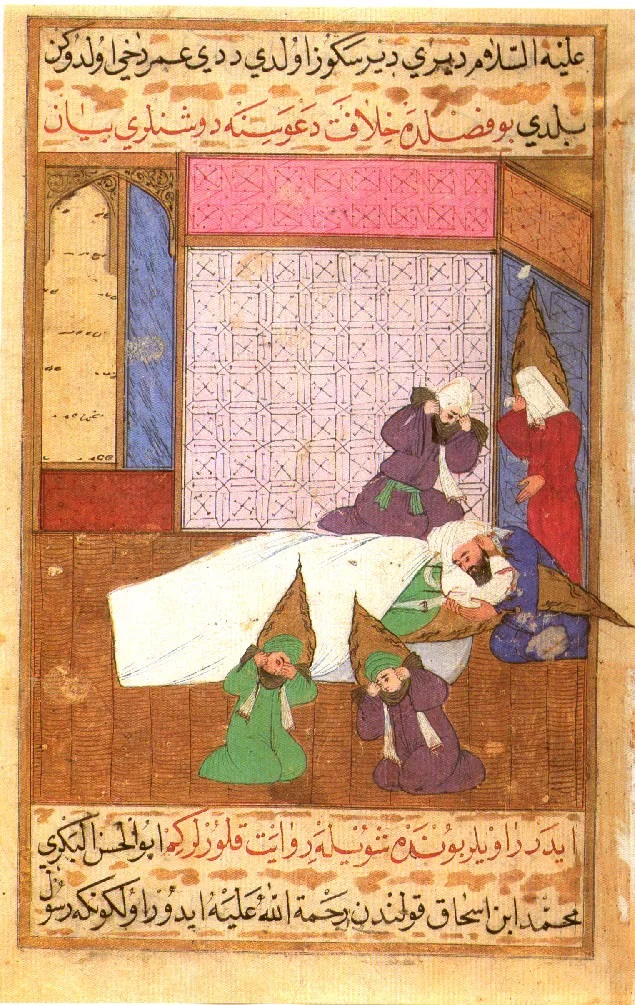
Respecting the visual arts, let us first stress that, contrary to the prevailing opinion, the Koran does not prohibit figurative images. There is no explicitly stated and universally accepted “ban” on images of living figures in Islamic legal texts. On the other hand, Islam, like other major religions, condemns the worship of idols.
From the eighth to the fifteenth century, numerous historical and poetic texts, both Sunni and Shi’a, many of which appeared in Turkish and Persian contexts, include admirable depictions of the Prophet Muhammad. The purpose of these images was not only to praise and pay homage to the Prophet, but represent occasions and central elements for the practice of Muslim faith.
In this respect, the book by the German art historian Hans Belting with the catchy title Florence & Baghdad, Renaissance Art and Arab Science (2011) is not only misleading but downright outrageous. Belting presents “Islam” as an aniconic faith (banning all human and animal representations), while in reality, besides exquisite calligraphy and geometric patterns in search for the infinite, representations of men and animals are an essential part of Islamic artistic expression.
In addition, other religions have experienced strong outbreaks of iconoclasm. For example, and this is one of the reasons why so little is known about ancient Greek painting, between 726 and 843, the Byzantine Empire ordered the systematic destruction of images representing Christ or the saints, whether they were mosaics adorning church walls, painted images or book illuminations.
From there on, Belting, for whom Islam is in essence an aniconic civilization, has great difficulty in demonstrating what he announces in the title: the influence of Arab science (notably Ibn al-Haytam work on human vision) on the Renaissance in Florence (in particular its definition of “geometric perspective”). In fact, presenting himself as an erudite, peaceful and “objective” scholar, Belting’s book feeds into the bellicose thesis of a supposed “Clash” of civilizations, while claiming the opposite.
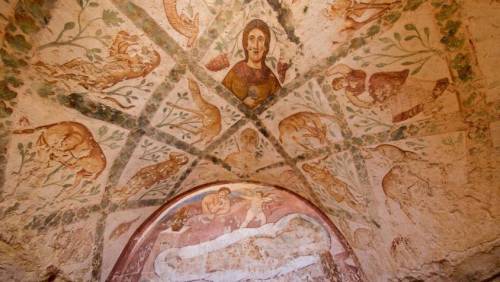

The first manifestations of pictorial art in the Arab-Muslim world date back to the Omayyad period (660-750). It is from this period that date the famous “desert castles”, such as Qusayr ‘Amra, in Eastern Jordan. Covered with wall paintings, these palaces reflect a contribution of the Byzantine, but also Persian Sassanid modes of representation. Thus, in the palace of Qusayr ‘Amra, used as a resort by the Caliph or his princes for sport and pleasure, the frescoes depict constellations of the zodiac, hunting scenes, fruits and women in the bath.
In the field of literature, Al-Rashid built up a vast library including a collection of rare books as well as thousands of books that kings and princes of the ancient world offered him.
For example, Kalila and Dimna, also known as the Indian Fables of Bidpaï, one of the most popular works of world literature. Compiled in Sanskrit nearly two thousand years ago, these animal fables, from which Aesop and La Fontaine drew, were translated from China to Ethiopia. Translated into Arabic around 750 by Ibn al-Muqaffa, they were richly illustrated in the Arab, Persian and Turkish worlds. The oldest illustrated Arabic version was probably produced in Syria in the 1200s. The landscape is symbolized by a few elements: a strip of grass, shrubs with stylized leaves and flowers. Men and animals are represented with bright colors and simplified lines.
A true manual for the education for kings, one of the fables evokes the idea,
of creating a university dedicated to the study of languages,
ancient and modern, and to the preservation,
in renewed forms, of the heritage of the human species…

And at the end of his story, the wise Bidpaï warns the young king Dabschelim:
“I must emphasize this last point: my stories require, at this stage, no extra commentary, wretched imaginings, or vapid guesswork by you, me, or anyone else. The very worst habit would be that of moralizing away the effective substance. Thus the urge to tag tidy little rationalizations, persuasive formulas, intellectual summaries, symbolical labels, or nay other convenient pigeon-holing device, mus be steadfastly resisted. Mental encapsulation perverts the medecine, rendering it impotent. It amount to a bypass around the story’s true destination; to explain away is to forget. It is also a type of hypocrisy – poisonous, an antidote to truth. Thus, let the stories which you can remember do their own work by their very diversity. Familiarize yourself with them, but fiddle with them not.”
Also noteworthy is The Sessions of the poet and man of letters Al-Hariri (1054-1122) [*7], written at the end of the tenth century and which had a tremendous diffusion throughout the Arab world. The text, which recounts the adventures of the brigand Abu Zayd, is particularly suitable for illustration.
Al-Ma’mûn and the Houses of Wisdom (Bayt al-Hikma)

After a violent dispute with his brother who sought to remove him from power, Al-Ma’mûn, the youngest son of Al-Rashid, became the eighth Abbasid caliph in 813. He was particularly interested in the work of scholars, especially those who knew Greek. He gathered in Baghdad thinkers of all beliefs, whom he treated magnificently and with the greatest tolerance. They all wrote in Arabic, a language that allowed them to understand each other. He brought manuscripts from Byzantium to enrich the vast library of his father. Open to scholars, translators, poets, historians, physicians, astronomers, scientists and philosophers, this first public library became the basis of the Bayt Al-Hikma (the “Houses of Wisdom”) combining translation, teaching, research and even public health activities, long before the Western universities. It was here that all known scientific manuscripts of the time, especially Greek writings, were gathered for study.
In Baghdad, this cultural bubbling will not remain confined to the Court but will go down to the street as this description of Baghdad by Ibn Aqul (died in 1119) testifies:
“First there is the large space called the Bridge Square. Then the Birds’ Market, a market where one can find all kinds of flowers and on the sides of which are the elegant stores of the money changers. (…) Then the caterers’ market, the bakers’ market, the butchers’ market, the goldsmiths’ market, unrivaled for the beauty of its architecture: high buildings with teak beams, supporting corbelled rooms. Then there is the huge booksellers’ market, which is also the gathering place for scholars and poets, and the Rusafa market. In the markets of Karkh and the Gate of the Ark, the perfumers do not mix with the merchants of grease and products with unpleasant smells; in the same way the merchants of new objects do not mix with the merchants of used objects.”
Persia, the Nestorians and medicine

As a model for the Houses of Wisdom, the Persian influence and precedents are often mentioned. It is true that the Barmakids, a family of Persian origin [*8], had a great influence on the first Abbasid caliphs.
In fact, al-Ma’mûn’s tutor was Jafar ben Yahya Barmaki (767-803), a member of the family of the Armenians and the son of the Persian vizier of his father Al-Rashid. The Persian elite who advised the Abbasid caliphs took a keen interest in the works of the Greeks, whose translation had begun during the reign of the Sassanid king Khosro I Anushirvan (531-579).
The latter founded the Academy of Medicine in Gondichapur. Many Nestorian (Christian) scribes and scholars had taken refuge there after the Council of Ephesus in 431. [*9]
The liturgical language of the Nestorians was Syriac, a Semitic dialect [*10].

Like the Jews, these Nestorian Christians possessed a cosmopolitan culture and a knowledge of languages (Syriac and Persian) that enabled them to act as intermediaries between Iran and its neighbors. And thanks to their access to the wisdom of ancient Greece, they were often employed as physicians. [*11]
The Academy of Medicine of Gondichapur [*12] had reached its peak in the 5th century thanks to the Syriac scholars expelled from Edessa. In this school, medicine was taught based on the translations of the Greek scholar and physician Claudius Galen. These teachings were put into practice in a large hospital, a tradition taken up in the Muslim world. This school was a meeting place for Greek, Syriac, Persian and Indian scholars, whose scientific influence was mutual. Heir to the Greek medical knowledge of Alexandria, the school of Gondichapur trained several generations of physicians at the court of the Sassanid and later at that of the Muslim Abbasid. As early as 765, the Abbasid caliph Al-Mansur, who reigned from 754 to 775, consulted the head of the Gondichapur hospital, Georgios ben Bakhtichou, and invited him to Baghdad. His descendants will work and teach medicine there. Long after the establishment of Islam, the Arab elites sent their sons to this Nestorian Christian school.
Timothy I (727-823) was the Christian patriarch of the Church of the East (“Nestorian”) between 780 and 823. His first decision was to establish the seat of his church in Baghdad, where it was to remain until the end of the thirteenth century, thus forging privileged links between the Nestorians and the Abbasid caliphs. A man with a good command of Syriac, Arabic, Greek and eventually Pehlevi, Timothy enjoyed the consideration of the Abbasid caliphs Al-Mahdi, Al-Rashid and Al-Ma’mûn.
During his forty-three years of pontificate, the Eastern Church lived in peace. Moreover, the Nestorians played a major role in the spread of Christianity in Central Asia as far as China via the Silk Road. In Central Asia, before the arrival of Islam, it was Sogdian, (the Iranian language of Sogdia and its capital Samarkand) that served as the lingua franca on the Silk Road. [*13]
Translating, understanding, teaching, improving
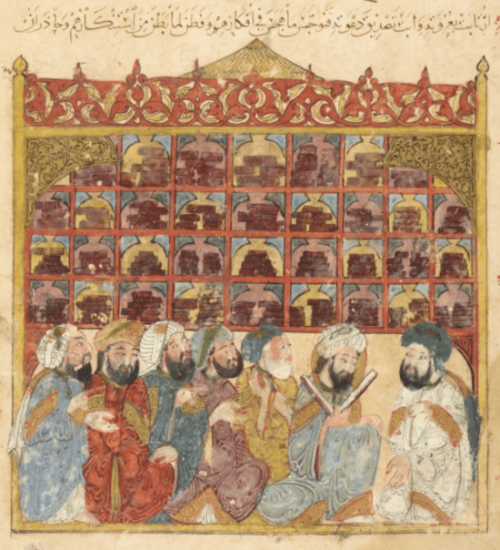
In Baghdad and Basra, in the Houses of Wisdom, the histories and texts collected after the collapse of the empire of Alexander the Great were translated and made available to scholars, texts initially collated and translated from Syriac into Persian under the aegis of the Sassanid emperors.
The Arab historian and economist Ibn Khaldun (1332-1406), who came from a large Andalusian family of Yemeni origin, paid tribute to this effort to preserve and disseminate the Greek heritage: “What happened to the sciences of the Persians whose writings, at the time of the conquest, were annihilated by order of Omar? Where are the sciences of the Chaldeans, the Assyrians, the inhabitants of Babylon? Where are the sciences that reigned among the Copts in the past? There is only one nation, that of the Greeks, whose scientific productions we possess exclusively, and that is thanks to the care that Al-Ma’mûn took in translating these works.”
These first translations into Arabic made available to the Arab-Muslim world hundreds of texts on philosophy, medicine, logic, mathematics, astronomy, music, etc., from Greek, Pehlevi, Syriac, Hebrew, Sanskrit, etc, including those of Plato, Aristotle, Pythagoras, Sushruta, Hippocrates, Euclid, Charaka, Ptolemy, Claudius Galen, Plotinus, Aryabhata and Brahmagupta.

They were accompanied by reflections, commentaries, translations of commentaries, etc. and gave rise to a new form of literature. According to the Nestorian patriarch Timothy I, it was at the request of the Caliph Al-Mahdi that he translated Aristotle’s Topics from Syriac into Arabic. He also wrote a treatise on astronomy entitled The Book of Stars, now lost.
An astrology and astronomy enthusiast, Al-Ma’mûn once made it a condition of peace with the Byzantine Empire to hand over a copy of the Almagest, Ptolemy’s main work, which was supposed to summarize all Greek astronomical knowledge. In 829, in the upper district of Baghdad, he built the first permanent observatory in the world, the Baghdad Observatory, allowing his astronomers, who had translated the Astronomical Treatise of the Greek Hipparchus of Nicaea (190-120 B.C.), as well as his star register, to methodically monitor the movement of the planets.
Here is what Sâ’id al-Andalusî (1029-1070) tells us about Al-Ma’mûn’s interest in astronomy and his efforts to advance it:
“As soon as Al-Ma’mûn became caliph, his noble soul made every effort to attain wisdom, and to this end he was particularly concerned with philosophy; moreover, the scholars of his time studied in depth a book by Ptolemy and understood the diagrams of a telescope that was drawn therein. So Al-Ma’mûn gathered all the great scholars present throughout the regions of the caliphate, and he asked them to build the same kind of instrument so that they could observe the planets in the same way as Ptolemy had done and those who had preceded him. The object was built and the scholars brought it to the city of al-Shamâsiyya in the region of Damascus in the Sham in the year 214 AH (829 AD). Through their observations they determined the exact duration of a solar year as well as the inclination of the sun, the exit of its center and the situation of its various faces, which allowed them to know the state and positions of the other planets. Then the death of the caliph al-Ma’mûn in 218 A.H. (833) put an end to this project, but they nevertheless completed the astronomical telescope and named it ‘the Ma’mûn telescope’”
Now, let me present you a short list of the main astronomers, mathematicians, thinkers, scholars and translators who frequented the Houses of Wisdom:
—Al-Jahiz (776-867). The encyclopedic approach of this Mutazilite is conceived as « a necklace gathering pearls » or as a garden which, with its plants, its harmonious organization and its fountains, represents in miniature the whole universe. He sketches the principle of the evolution of species;
—Al-Khwarizmi (780-850), (in Latin Algorithmus). This Persian mathematician and astronomer, according to some a Zoroastrian converted to Islam, would have been a follower of mutazilism. He is best known for having invented the method of solving mathematical problems, which is still used today and which is called algorithm. He studied for some time in Baghdad but it is also reported that he made a trip to India. Al Khawarizmi invented the word algebra (from the Arabic word j-b-r, meaning force, beat or multiply), introduced the Indian numerical system to the Muslim world, institutionalized the decimal system in mathematics, and formalized the testing of scientific hypotheses based on observations;
—Sahl Rabban al-Tabari (786-845), a Jewish astronomer and physician whose name means “The son of the rabbi of Tabaristan”. His son Ali was the tutor of al-Razi (865-925). An alchemist who became a physician, he is said to have isolated sulfuric acid and ethanol and was among the first to advocate their medical use. He greatly influenced the conception of hospital organization in connection with the training of future doctors. He was the object of much criticism for his opposition to Aristotelianism;
—Al-Hajjaj (786-823) made the first Arabic translation of Euclid’s Elements from Greek. He also translated Ptolemy’s Almagest;
—Al-Kindi (801-873) (known as Alkindus), considered the father of Arab philosophy, was a mutazilist. He was a prolific author (about 260 books) and explored all fields: geometry, philosophy, medicine, astronomy, physics, arithmetic, logic, music and psychology. Along with his colleagues, Al-Kindi was entrusted with the translation of the manuscripts of Greek scholars. After the death of Al-Ma’mun in 833, he was considered too much of a mutazilist, fell into disgrace and his library was confiscated;
—The Banu Musa (“children of Moses”) brothers, three brilliant sons of a deceased astrologer, friend of the Caliph. Mohammed will work on astronomy; Ahmed and Hassan on the canals linking the Euphrates to the Tigris, a guarantee of the control and optimization of their respective floods. They published the Book of Ingenious Mechanisms, an inventory of new techniques and machines [*14];
—Hunayn ibn Ishâk (808-873) (known as Iohannitius). This Nestorian Christian was entrusted by Al-Ma’mun with the task of overseeing the quality of translations; a physician, he translated some of the works of the Greek physician Claudius Galen;
—Thabit ibn Qurra (836-901), a Syrian astronomer, mathematician, philosopher and musicologist;
—Qusta ibn Luqa (820-912), a Greek Byzantine physician, also a philosopher, mathematician, astronomer, naturalist and translator. A Christian of the Melkite Church, he spoke both Greek (his mother tongue) and Arabic, as well as Syriac. Considered, along with Hunayn ibn Ishaq, as one of the key figures in the transmission of Greek knowledge from Antiquity to the Arab-Muslim world. He was the translator of Aristarchus of Samos for whom the Earth revolved around the Sun and the author of a treatise on the astrolabe;
—Ibn Sahl (940-1000), in the footsteps of Al-Kindi, wrote a treatise on burning mirrors and lenses around 984, explaining how they can focus light on a point. His work was perfected by Ibn Al-Haytam (965-1040) (Latin name: Alhazen), whose writings reached as far as Leonardo da Vinci, via the Commentaries of Ghiberti. In Ibn-Sahl, we find the first mention of the law of refraction, later rediscovered in Europe as the law of Snell-Descartes.
Drawn into Bagdad for the opportunities it offered, these scholars generally worked in teams in a totally interdisciplinary spirit. Al-Ma’mûn, monitoring the science projets and noting the contradictions that arose from the translations of Greek, Persian and Indian sources, fixed with the scholars the next great scientific challenges to be met:
–To obtain, thanks to more efficient astronomical observatories, tables of astronomical ephemerides [*15] of greater precision than those of Ptolemy;
–To calculate with precision the circumference of the Earth with more advanced methods than those of the Greek astronomer Eratosthenes (3rd century BC);
–Produce a world map integrating the latest geographical knowledge concerning the distances between cities and the size of the continents;
–Deciphering the Egyptian hieroglyphs that Al-Ma’mûn had discovered during his trip to Egypt.
Translations of Plato

By asserting that what had advanced science at this period was the rediscovery of Aristotle and his purely empiricist method, one forgets the rediscovery of Plato, whose dialectical and hypothetical method has often done more for science than blind empiricism.
Al-Kindi’s intense involvement in the Platonic tradition is reflected in his summaries of the Apology and the Crito, and in his own works that paraphrase the Phaedo or are inspired by the Meno and the Symposium. The Syrian scientist Ibn al-Bitriq, a member of Al-Kindi’s “circle” in Bagdad, translated the Timaeus.
Otherwise, the House of Wisdom’s top translator, Hunayn ibn Ishaq and his circle translated the Greek physician Claudius Galen’s commentaries on the Timaeus, especially his On what Plato said in the Timaeus in a medical way and his On the doctrines of Hippocrates and Plato. And from Hunayn’s own works, we know that some of his students translated Galen’s lost Greek summaries of Plato’s Cratylus, Sophist, Parmenides, Euthydemus, Republic and Laws. Finally, the physician al-Razi presented and commented on Plutarch’s treatise On the Generation of the Soul in the Timaeus.
Inter-religious dialogue:
possible for some, complicated for others
In the West, the name of Al-Kindi is best known in association with The Apology of Al-Kindi, an anonymous text of the time. It is probably a fictitious dialogue between two believers, one Muslim (Abdallah Al-Hashimi), the other Christian (Al-Kindi), both criticizing the other’s and praising one’s own religion and inviting the other to join him! This dialogue supposedly took place at the time of the caliph Al-Ma’mûn. What we know about the open-mindedness of the Caliph does not contradict this assertion. The earliest known mention of the existence of this Apology came to us from Al-Biruni (973-1048).
The manuscript of Al-Kindi’s Apology was translated into Latin in 1142 at the request of Peter the Venerable (1092-1156), grand abbot of the abbey of Cluny, the most powerful and important in Latin Europe. That same year, after visiting Toledo, he conceived the idea of a systematic refutation of the Muslim religion, which he considered heretical and errant.
Here is how he explains the translation he has just ordered of the Koran (the Lex Mahumet pseudoprophete) by a team of translators (including an Arab) brought together for the occasion:
“Whether one gives the Mohammedan error the shameful name of heresy or the infamous one of paganism, one must act against it, that is, write. But the Latins and especially the moderns, the ancient culture perishing, according to the word of the Jews who once admired the polyglot apostles, do not know any other language than that of their native land. So they could neither recognize the enormity of this error nor stop it. So my heart was inflamed and a fire burned in my meditation. I was indignant that the Latins did not know the cause of such a perdition and their ignorance robbed them of the power to resist it; for no one answered, for no one knew. So I went to find specialists in the Arabic language which has allowed this deadly poison to infest more than half the globe. I persuaded them, by dint of prayers and money, to translate from Arabic into Latin the history and doctrine of this wretched man and his very law, which is called Koran”.
Accused hence “the Arabic language which allowed this deadly poison (Islam) to infest more than half of the globe”…
This declaration of war was undoubtedly required to motivate his troops. Let us recall that Eudes de Châtillon, the grand prior of the abbey of Cluny, who will become Pope Urban II in 1088, will be, in 1095, at the origin of the first crusade sending the bandits who ravaged France, to go and wage war elsewhere.
The decline and Al-Ghazali
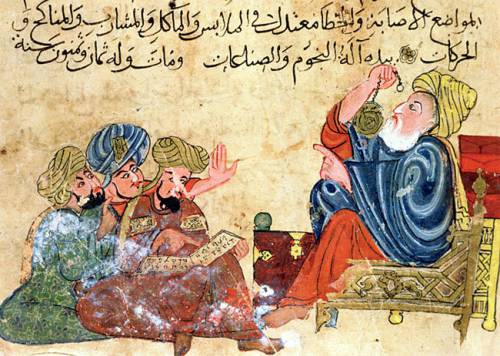
Let us return to the Abbasids. As we have said, with the arrival in power of Al-Mutawakkil in 847, mutazilism was removed from power and the Houses of Wisdom were reduced to simple libraries. This did not prevent a traveller, describing his visit to Baghdad in 891, from reporting that the city contained more than one hundred public libraries. Following the Bayt Al-Hikma model, small libraries were founded on every street corner of the city…
Entangled in endless theological debates between experts and won by sectarianism, the mutazilist elite cut itself off from a people who were losing confidence and eventually welcomed with a sense of relief the obscurantist doctrine of Al-Ghâzalî (1058-1111) (Latin name: Algazel), the worst enemy of the mutazilites.
Al-Ghâzalî proposed a radical solution: philosophy is only right when it agrees with religion – which, according to Al-Ghâzalî, is rare. This leads him to radicalize his position, and to attack more and more the Greco-Arab philosophy, guilty, in his eyes, of blasphemy.
Where someone like the Persian Ibn Sina (980-1037) (Latin name: Avicenna), author of the Canons or Precepts of Medicine (around 1020), crossed Greek philosophy and Muslim religion, Al-Ghazali wanted to filter the first through the second.
Hence his most famous and important work, The Incoherence of the Philosophers, written in 1095. In it, he denounces the “pride” of the philosophers who claim to “rewrite the Koran” through Plato and Aristotle. Their error is above all a logical one, as the title of the book itself indicates, which underlines their “incoherence”: they want to complete the Koran with Greek philosophy, whereas the Koran comes later in history and therefore does not need to be completed. He therefore promotes a much more literal approach to the Koranic text, whereas Ibn Sina defended, cautiously it is true, a metaphorical approach. In truth, it is Aristotelianism and nominalism that triumph. The doctrine opposing Mutazilism became known as Ash’arism.
For Ascharites, to speak of God’s justice and rationality is a double blasphemy, because it amounts to limiting his omnipotence. If God were, as the Mutazilites say, compelled to will what is good, then he would be … compelled, which the Ascharites find theologically unacceptable. Therefore, believers should not admit the idea that God wills good, but submit to the principle that whatever he wills is good because he wills it.
Similarly, it is blasphemous to look for « second causes » in nature, i.e. scientific laws. The world exists because God, at every moment, wants it to exist. Any scientific research, any attempt to apply reason and analysis, is an offense to the divine omnipotence.
For Sébastien Castellion, the rejection of reason by the Ascharite school – and subsequently by much of Muslim civilization – was not an implicit and subterranean process, but an explicit decision based on theological principles. The great jurist Ibn Hanbal, whose school is predominant in Saudi Arabia today, said that « all those who indulge in reasoning by analogy and personal opinions are heretics (…). Accept only, without asking why and without making comparisons. »
The fall of Bagdad
From the eleventh century onward, the Abbasid, whose Empire was fragmenting, called upon the Turkish Seljuk princes to protect them against the Shiites, supported by the Fatimid caliphate of Cairo. Gradually, the Turkish and Mongol troops, coming from Central Asia, ended up governing the security of the Abbasid caliph while letting him exercise his religious power.
Then, in 1258, they deposed the last caliph and confiscated his title of successor of the Prophet, which gave them religious power over the four schools of Sunnism. In order to subdue the Arab and Persian populations, the Seljuk Turks created the madrasa (Koranic school) where the conservative doctrine of Acharite Sunnism was taught to the exclusion of the dialectical Mutazilite theology, considered an ideological threat to Turkish authority over the Arabs.
The Abbasid Empire declined as a result of administrative negligence, abandonment of canal maintenance, flood-induced famine, social injustice, slave revolts, and religious tensions between Shiites and Sunnis. At the end of the 9th century, the Zendj, black slaves (from Zanzibar) who worked in the marshes of the lower Iraq, revolted several times, even occupying Basra and threatening Baghdad. The Caliph restored order at the cost of an unprecedentedly violent repression. The rebels were only crushed in 883 at the cost of many victims. The empire did not recover.
In 1019, the Caliph forbade any new interpretation of the Koran, radically opposing the Mutazilite school. This is a brutal stop to the development of critical thinking and intellectual and scientific innovations in the Arab Empire, the consequences of which are still felt today.
ASTRONOMY
Since the dawn of time (it is the case to say it), man has tried to understand the organization of the stars in the environment near the Earth.
Installations such as Stonehenge (2800 BC) in England allowed the first observers to identify the cycles that determine the place and the exact day when certain stars rise. All these observations posed paradoxes: around us, the earth appears relatively flat, but the Moon or the Sun that we perceive with the same eyes seem spherical. The Sun « rises » and « sets », our senses tell us, but where is the reality?
It seems that Thales of Miletus (625-547 BC) was the first to have really wondered about the shape of the Earth. He thought that the Earth was shaped like a flat disk on a vast expanse of water. Then Pythagoras and Plato imagined a spherical shape, which they considered more beautiful and rational. Finally Aristotle reported some observational evidence such as the rounded shape of the Earth’s shadow on the Moon during eclipses.
The Greek scientist Eratosthenes (276 BC- 194 BC), chief librarian of the Alexandria library, then calculated the Earth’s circumference. He had noticed that at noon, on the day of the summer solstice, there was no shadow on the side of Aswan. By measuring the shadow of a stick planted in Alexandria at the same time and knowing the distance between the two cities, he deduced the circumference of the Earth with a rather astonishing accuracy: 39,375 kilometers against some 40,000 kilometers for current estimates.
Between Ptolemy’s Almagest and Copernicus’ De Revolutionibus, as we have said, Arabic astronomy constitutes “the missing link”.
The original title of Ptolemy’s work is The Mathematical Composition. The Arabs, very impressed by this work, called it “megiste”, from the Greek meaning “very great”, to which they added the Arabic article “al”, to give “al megiste” which became Almageste.
It is important to know that Ptolemy never had the opportunity to re-read his treatise as a whole. After writing the first of the thirteen books of his work, the one on “The Fundamental Postulates of Astronomy”, Ptolemy passed it on to copyists who reproduced it and distributed it widely without waiting for the completion of the other twelve books…

In the end, confronted with observations that called into question his own observations and in order to rectify his errors, Ptolemy wrote another work, after the Almagest, entitled Planetary Hypotheses. The author returned to the models presented in the Almagest while making modifications to the average motions (of the planets) to take into account the latest observations. However, his Planetary Hypotheses went beyond the mathematical model of the Almagest to present a physical realization of the universe as a set of nested spheres, in which he used the epicycles of his planetary model to calculate the dimensions of the universe. Finally, the Almagest also contains a description of 1022 stars grouped into 48 constellations.
Ptolemy also presents stereographic projection invented by Hipparchus, the theoretical basis for the construction of the astrolabe by Arab astronomers.
In the ninth century, when the Arabs became interested in astronomy, knowledge was based on the following principles summarized in the work of Ptolemy:
–Ignoring the assertions of Aristarchus of Samos (310-230 BC) for whom the Earth revolved around the Sun, Ptolemy resumed in the second century AD the thesis of Eudoxus of Cnidus (approx. 400-355 BC) and especially Hipparchus (180 to 125 BC) to assert that the Earth is a motionless sphere placed at the center of the world (geocentrism);
–Ptolemy agreed with Plato, who was inspired by Pythagoras, that the circle was the only perfect form, and that the other bodies turning around the Earth did so according to circular and uniform trajectories (without acceleration or deceleration);
–Yet everyone knew that some planets do not follow these perfect rules. In the 6th century, the neo-Platonic philosopher Simplicius, in his Commentary on Aristotle’s Physics, wrote: “Plato then poses this problem to the mathematicians: what are the uniform and perfectly regular circular motions that should be taken as hypotheses, so that we can save the appearances that the wandering stars present?” ;
–In order to account for the « apparent retrograde motion » of Mars, Hipparchus will introduce other secondary perfect figures, again circles. The articulation and interaction of these “epicycles” gave the appearance of sticking with the observed facts. Ptolemy took up this approach;
–However, the more the precision of astronomical measurements improved, the more anomalies were discovered and the more it was necessary to multiply these interlocking “epicycles”. It quickly became very complicated and inextricable;
–The universe is divided into a sub-lunar region where everything is created and therefore perishable, and the rest of the universe, supra-lunar, which is imperishable and eternal.
Hipparchus of Nicea

The Arab astronomers, for both religious and intellectual reasons that we mentioned at the beginning of this article, initially discovered and then, on the basis of increasingly detailed observations, challenged Hipparchus’ hypotheses, which were the basis of the Ptolemaic model.
Hipparchus imagined a system of coordinates for the stars based on longitudes and latitudes. We also owe him the use of parallels and meridians to locate the Earth as well as the division of the circumference into 360° inherited from the sexagesimal calculation (base 60) of the Babylonians.
In astronomy, his works on the rotation of the Earth and the planets are numerous. Hipparchus explains the mechanism of the seasons by noting the obliquity of the ecliptic: the inclination of the Earth’s axis of rotation. By comparing his observations with older ones, he discovered the precession of the equinoxes due to this tilt: the Earth’s axis of rotation makes a conical movement from East to West and of revolution 26,000 years. Thus in a few millennia, the North Pole will no longer be found with the North Star (Polaris) but with another star, Vega.
Based on Hipparchus, the Arabs perfected and fabricated an important instrument for measuring positions: the astrolabe. This “mathematical jewel” allows to measure the position of stars, planets, to know the time on Earth. Later, the astrolabe was replaced by more precise and easier to use instruments, such as the quadrant, the sextant or the octant.
With the manuscripts at their disposal in the Houses of Wisdom and the observatories of Baghdad and Damascus, the Arab astronomers had texts of an incredible richness but often in flagrant contradiction with their own observations of the movements of the Moon and the Sun. It is from this confrontation that later discoveries were born. The Arabs introduced a lot of mathematics to solve problems, especially trigonometry and algebra.
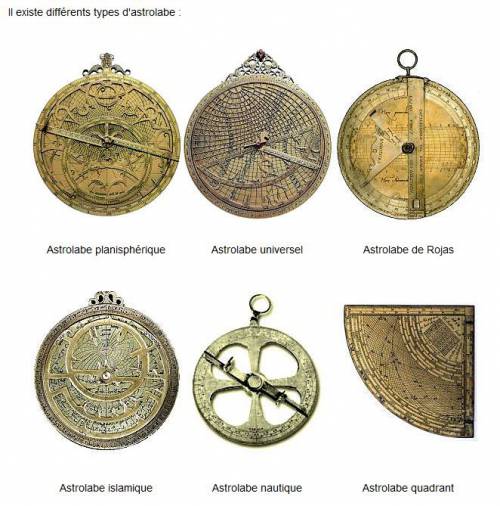
The Arab astronomers
In order to present the main Arab astronomers and their contributions, here is an excerpt from J. P. Maratray’s remarkable article L’astronomie arabe.
—Al-Khwarizmi (783-850) called Algorithmi.
A mathematician, geographer and astronomer of Persian origin, he was a member of the « House of Wisdom ». He is one of the founders of Arab mathematics, inspired by Indian knowledge, in particular the decimal system, fractions, square roots… He is credited with the term “algorithm”. Algorithms are known since antiquity, and the name of Al-Khwarizmi (Algorithmi in Latin) will be given to these sequences of repeated elementary operations. He is also the author of the term “algebra”, which is the title of one of his works on the subject. He was also the first to use the letter x to designate an unknown in an equation. He wrote the first book of algebra (al-jabr) in which he described a systematic method of solving second degree equations and proposed a classification of these equations. He introduced the use of numbers that we still use today. These “Arabic” numbers are in fact of Indian origin, but were used mathematically by Al-Khwarizmi. He adopted the use of the zero, invented by the Indians in the 5th century, and adopted by the Arabs through him. The Arabs will translate the Indian word “sunya” by “as-sifr”, which becomes “ziffer” and “zephiro”. Ziffer will give “number”, and zephiro, “zero”. Al-Khwarizmi established astronomical tables (position of the five planets, the Sun and the Moon) based on Hindu and Greek astronomy. He studied the position and visibility of the Moon and its eclipses, the Sun and the planets. It is the first completely Arabic astronomical work. A crater of the Moon bears his name.
—Al-Farghani (805-880) called Alfraganus (mentioned in Dante’s Commedia).
Born in Ferghana in present-day Uzbekistan, he wrote in 833 the Elements of Astronomy, based on the Greek knowledge of Ptolemy. He was one of the most remarkable astronomers in the service of Al-Ma’mûn, and a member of the House of Wisdom. He introduced new ideas, such as the fact that the precession of the equinoxes must affect the position of the planets, and not only that of the stars. His work was translated into Latin in the 12th century, and had a great impact on the very closed circles of Western European astronomers. He determined the diameter of the Earth, which he estimated at 10500 km. We also owe him a work on sundials and another on the astrolabe.
—Al-Battani (850-929) called Albatenius.
He observed the sky from Syria. He is sometimes called “the Ptolemy of the Arabs”. His measurements are remarkably accurate. He determined the length of the solar year, the value of the precession of the equinoxes, the inclination of the ecliptic. He noted that the eccentricity of the Sun is variable, without going so far as to interpret this phenomenon as an elliptical trajectory. He wrote a catalog of 489 stars. We owe him the first use of trigonometry in the study of the sky. It is a much more powerful method than the geometrical one of Ptolemy. His main work is The Book of Tables. It is composed of 57 chapters. Translated into Latin in 1116 by Plato of Tivoli, it will greatly influence the European astronomers of the Renaissance.
—Al-Soufi (903-986) known as Azophi.
Persian astronomer, he translated Greek works including the Almagest and improved the estimates of the magnitudes of stars. In 964, he published « The Book of Fixed Stars », where he drew constellations. He seems to have been the first to report an observation of the large Magellanic cloud (a nebula), visible in Yemen, but not in Isfahan. Similarly, we owe him a first representation of the Andromeda galaxy, probably already observed before him. He described it as « a small cloud » in the mouth of the Arabian constellation of the Great Fish. Its name (Azophi) was given to a crater on the Moon.
—Al-Khujandi (circa 940- circa 1000).
He was a Persian astronomer and mathematician. He built an observatory in Ray, near Tehran, with a huge sextant, constructed in 994. It is the first instrument able to measure angles more precise than the minute of angle. He measures with this instrument the obliquity of the ecliptic, by observing the meridian passages of the Sun. He found 23° 32′ 19 ». Ptolemy found 23° 51′, and the Indians, much earlier, 24°. The idea of the natural variation of this angle never occurred to the Arabs. They discussed for a long time about the accuracy of the measurements, which made their science advance.
—Ibn Al-Haytam (965-1039) called Alhazen.
A mathematician and optician born in Basra in present-day Iraq, he was asked by the Egyptian authorities to solve the problem of the Nile floods. His solution was the construction of a dam towards Aswan. He gave up in front of the enormity of the task (the dam was finally built in 1970!). Faced with this “failure”, he feigned madness until the death of his boss. He made a critical assessment of Ptolemy’s theses and those of his predecessors, and wrote Doubts on Ptolemy. He draws up a catalog of the inconsistencies, without however proposing an alternative solution. Among the inconsistencies he noted were the variation in the apparent diameter of the Moon and the Sun, the non-uniformity of the allegedly circular motions, the variation in the position of the planets in latitude, the organization of the Greek spheres. Observing that the Milky Way has no parallax, he placed it very far from the Earth, in any case further away than Aristotle’s sub-lunar sphere. Despite his doubts, he maintains the central place of the Earth in the universe. Ibn Al-Haytam takes up the work of Greek scholars, from Euclid to Ptolemy, for whom the notion of light is closely linked to the notion of vision: the main question being whether the eye has a passive role in this process or whether it sends a kind of fluid to “interrogate” the object. Through his studies of the mechanism of vision, Ibn Al-Haytam showed that the two eyes were an optical instrument, and that they actually saw two separate images. If the eye sent this fluid, one could see at night, he speculated. He understood that the sunlight reflected off the objects and then entered the eye. But for him, the image is formed on the lens… He took up Ptolemy’s ideas on the rectilinear propagation of light, accepted the laws of reflection on a mirror, and sensed that light has a finite, but very great speed. He studied refraction, the deviation of a light ray as it passes from one medium to another, and predicted a change in the speed of light as it passes. But he could never calculate the angle of refraction. He found that the phenomenon of twilight is related to the refraction of sunlight in the atmosphere, which he tried to measure the height, without success. Already known in antiquity, we owe him a very precise description and the use for experimental purposes of the dark room (camera obscura), a black room that projects an image on a wall through a small hole drilled in the opposite wall. The result of all this optical research is recorded in his Treatise on Optics, which took him six years to write and was translated into Latin in 1270. [*16] In mechanics, he asserted that an object in motion continues to move as long as no force stops it. This is the principle of inertia before the letter. An asteroid bears his name: 59239 Alhazen.
—Al-Biruni (973-1048).
Certainly one of the greatest scholars of medieval Islam, originally from Persia, he was interested in astronomy, geography, history, medicine and mathematics, and philosophy in general. He wrote more than 100 works. He was also a tax collector and a great traveler, especially in India, where he studied language, religion and science. At the age of 17, he calculated the latitude of his native town of Kath (in Persia, now in Uzbekistan). At the age of 22, he had already written several short works, including one on cartography. In astronomy, he observed the eclipses of the Moon and the Sun. He is one of the first to evaluate the errors on his measurements and those of his predecessors. He noticed a difference between the average speed and the apparent speed of a star. He measured the radius of the Earth at 6339.6 km (the correct figure is 6378 km), a result used in Europe in the 16th century. During his travels, he met Indian astronomers who supported heliocentrism and the rotation of the Earth on its axis. He will always be skeptical, because this theory implies the movement of the Earth. But he will ask himself the question: « Here is a problem difficult to solve and to refute ». He believes that this theory does not lead to any mathematical problems. He refuted astrology, arguing that this discipline is more conjectural than experimental. In mathematics, he developed the calculation of proportions (rule of three), demonstrated that the ratio of the circumference of a circle to its diameter is irrational (future number Pi), calculated trigonometric tables, and developed methods of geodesic triangulations.
—Ali Ibn Ridwan (988-1061).
Egyptian astronomer and astrologer, he wrote several astronomical and astrological works, including a commentary on another book of Claudius Ptolemy, the Tetrabible. He observed and commented on a supernova (SN 1006), probably the brightest in history. Its magnitude is estimated today, according to the testimonies that have come down to us, at -7.5! It remained visible for more than a year. He explains that this new star had two to three times the apparent diameter of Venus, a quarter of the brightness of the Moon, and that it was low on the southern horizon. Other western observations corroborate this description, and place it in the constellation of the Wolf.
—From the 11th to the 16th century.
After a first phase, more important observatories were built. The first of them, model of the following ones, is that of Maragheh, in the current Iran. Their purpose was to establish planetary models and to understand the movement of the stars. (…) The school thus constituted will have its apogee with Ibn Al-Shâtir (1304-1375). Other observatories will follow, such as the one in Samarkand in the 15th century, Istanbul in the early 16th century, and, in the West, the one of Tycho Brahe in Uraniborg (Denmark at that time) at the end of the 16th century. The new models were no longer Ptolemaic inspired, but remained geocentric. The physics of the time still refused to put the Earth in motion and to remove it from the center of the world. These models were inspired by the Greek epicycles, keeping the circles, but simplifying them. For example, Al-Tûsî proposes a system comprising a circle rolling inside another circle of double radius. This system transforms two circular motions into an alternating rectilinear motion, and explains the variations of the latitude of the planets. Moreover, it accounts for the variations of the apparent diameters of the stars. But to go further, it will be necessary to change the reference system, which the Arabs refused to do. This change will occur with the Copernican revolution, during the Renaissance, in which the Earth loses its status as the center of the world.
—Al-Zarqali (1029-1087) said Arzachel.
Mathematician, astronomer and geographer born in Toledo, Spain, he discussed the possibility of the movement of the Earth. Like others, his writings will be known to Europeans of the sixteenth and seventeenth century. He designed astrolabes, and established the Toledo Tables, which were used by the great Western navigators such as Christopher Columbus, and served as a basis for the Alphonsine Tables. He established that the eccentricity of the Sun varies, more precisely that the center of the circle on which the Sun rotates moves periodically away from or towards the Earth. A crater of the Moon bears his name, as well as a bridge of Toledo on the Tagus.
—Omar Al-Khayyam (1048-1131).
Known for his poetry, he was also interested in astronomy and mathematics. He became director of the Isfahan observatory in 1074. He created new astronomical tables even more precise, and determined the duration of the solar year with great accuracy, given the instruments used. It is more accurate than the Gregorian year, created five centuries later in Europe. He reformed the Persian calendar by introducing a leap year (Djelalean reform). In mathematics, he was interested in third degree equations by demonstrating that they can have several solutions (he found some of them geometrically). He wrote several texts on the extraction of the cubic roots, and a treaty of algebra.
—Al-Tûsî (1201-1274).
Astronomer and mathematician, born in the city of Tus in present-day Iran, he built and directed the observatory of Maragheh. He studied the works of Al-Khayyam on proportions, and was interested in geometry. On the astronomical side, he commented on the Almagest and completed it, like several astronomers (Al-Battani…) before him. He estimates the obliquity of the ecliptic at 23°30′.
—Al-Kashi (1380-1439).
Persian mathematician and astronomer, he witnessed a lunar eclipse in 1406 and wrote several astronomical works afterwards. He spent the rest of his life in Samarkand, under the protection of Prince Ulugh Beg (1394-1449) who founded a university there. He became the first director of the new observatory of Samarkand. His astronomical tables propose values with 4 (5 according to the sources) digits in sexagesimal notation of the sine function. He gives the way to pass from a system of coordinates to another. His catalog contains 1018 stars. He improves the tables of eclipses and visibility of the Moon. In his treatise on the circle, he obtained an approximate value of Pi with 9 exact positions in sexagesimal notation, that is to say 16 exact decimals! A record, since the next improvement of the estimation of Pi dates from the 16th century with 20 decimals. He leaves his name to a generalization of the Pythagorean theorem to any triangles. This is the Al-Kashi theorem. He introduced the decimal fractions, and acquired a great reputation which made him the last great Arab mathematician astronomer, before the West took over.
—Ulugh Beg (1394-1449).
Grandson of Tamerlan, prince of the Timurid (descendants of Tamerlan). Viceroy from 1410, he acceded to the throne in 1447. He was a remarkable scholar and a poor politician, a position he delegated to devote himself to science. His teacher was Qadi Zada al-Rumi (1364-1436) who developed in him a taste for mathematics and astronomy. He built several schools, including one in Samarkand in 1420 where he taught, and an observatory in 1429. He worked there with some 70 mathematicians and astronomers (including Al-Kashi) to write the Sultanian Tables published in 1437 and improved by Ulugh Beg himself shortly before his death in 1449. The accuracy of these tables will remain unequaled for more than 200 years, and they were used in the West. They contain the positions of more than 1000 stars. Their first translation dates from around 1500, and was made in Venice.
—Taqi Al-Din (1526-1585).
After a period as a theologian, he became the official astronomer of the Sultan in Istanbul. He built an observatory there with the aim of competing with those of European countries, including that of Tycho Brahe. The observatory was opened in 1577. He drew up the Zij tables (“the unbroken pearl”). He was the first to use comma notation, rather than the traditional sexagesimal fractions in use. He observed and described a comet, and predicted that it was a sign of victory for the Ottoman army. This forecast turns out to be erronous, and the observatory is destroyed in 1580… He then devotes himself to mechanics, and describes the functioning of a rudimentary steam engine, invents a water pump, and is fascinated by clocks and optics.
The destruction of the observatory of Istanbul marks the end of the Arab astronomical activity of the Middle Ages. It was not until the Copernican revolution that new progress was made, and what progress! Copernicus and his successors were certainly strongly inspired by the results of the Arabs through their works. Travel and direct contact between scientists of the time were rare. Since Westerners did not understand Arabic, Latin translations probably influenced the West, along with the works of some Greek philosophers who had questioned the central position of the Earth, as Aristarchus of Samos had proposed around 280 BC.
Arab observatories
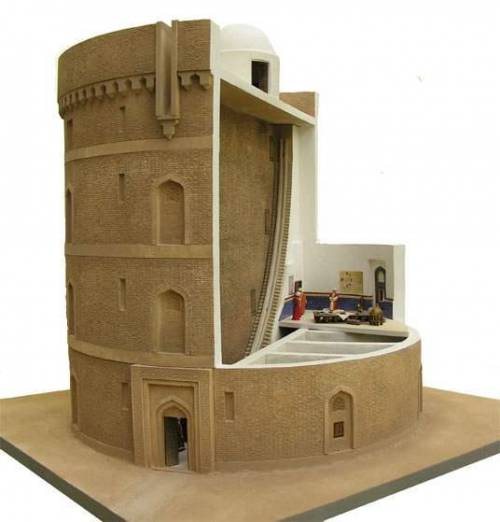
The modern observatory, in its conception, is a worthy successor of the Arab observatories of the late Middle Ages. Unlike the private observatories of the Greek philosophers, the Islamic observatory is a specialized astronomical institution, with its own premises, scientific staff, teamwork with observers and theoreticians, a director and study programs. They have recourse, as today, to increasingly large instruments, in order to constantly improve the accuracy of measurements.
The first of these observatories was built during the reign of Al-Ma’mûn in Bagdad in the 9th century. We have already mentioned the observatory of Ray, near Tehran and second city of the Abbasid Empire after Baghdad, with its monumental wall sextant dating from 994. To these must be added the observatories of Toledo and Cordoba in Spain, Baghdad and Isfahan.
Finally, the one in Maragheh in the north of present-day Iran, built in 1259 with funds collected to maintain hospitals and mosques. Al-Tusi worked there. Then came the era of the observatory of Samarkand, built in 1420 by the astronomer Ulugh Beg (1394-1449), whose remains were found in 1908 by a Russian team.

Conclusion
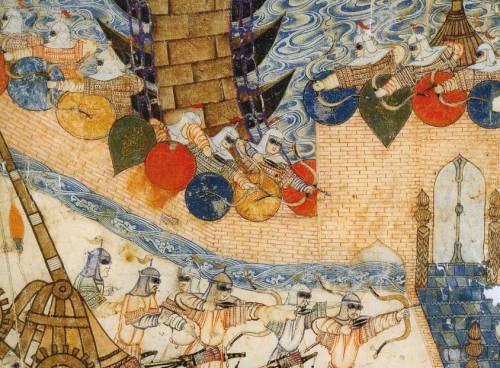
Much more than the crusades, it will be the Mongol offensives that will devastate entire sections of the Arab-Muslim civilization. Genghis Khan (1155-1227), to the great pleasure of some Westerners, will destroy the Muslim kingdoms of Khwarezm (1218) and Sogdia with Bukhara and Samarkand (1220). The great city of Merv in 1221. In 1238, his son will seize Moscow, then Kiev. In 1240, Poland and Hungary will be invaded. In 1241, Vienna was threatened.
Before bringing down the Song Dynasty in China in 1273, the Mongols turned against the Abbassid.
Hence, the Houses of Wisdom came to a brutal end on February 12, 1258 with the Mongol invasion of Baghdad led by Hulagu (Genghis Khan’s grandson), who killed the last Abbasid caliph Al-Mu’tassim (despite his surrender) and destroyed the city of Baghdad and its cultural heritage. Hulagu also ordered the massacre of the caliph’s entire family and entourage.
Mutazilism was banned and the magnificent collection of books and manuscripts in the House of Wisdom in Baghdad was thrown into the muddy water of the Tigris, which turned brown for a few days because of the inked papers of the books and manuscripts.
One report says that the Mongols exterminated twenty-four thousand scholars and an incalculable number of books were lost. Of Mutazilism, its doctrine was only known through the texts of the traditionalist theologians who had attacked it. It was only the discovery of the voluminous works of Abdel al Jabbar Ibn Ahmad in the 19th century that made it possible to understand the key role played my this current of thought in the Arab renaissance and the formation of current Muslim theology, whether Sunni or Shiite.
Closer to home, the Iraq war of 2003: until then, Iraq was the world’s largest publisher of scientific publications in Arabic. As a result of the chaos caused by a war waged in the name of “democracy” and “the war on terror”, both the National Library and the National Archives were looted and burned. The same happened to the Central Library of Pious Legacies, the Library of the Iraqi University of Sciences, as well as many public libraries in Baghdad, Mosul and Basra. The same was true for the archaeological treasures of the Iraqi Museum and its library. It seems that some people have declared war on civilization.

NOTES:
- A theodicy or « righteousness of God ») is an explanation of the apparent contradiction between the existence of evil and two characteristics peculiar to God: his omnipotence and his goodness.
- Sumer. The natural environment of the Sumerian country was not really favorable to the development of a productive agriculture: poor soils with a high content of salts harmful to the growth of plants, very high average temperatures, insignificant rainfall, and flooding of rivers coming in the spring, at harvest time, and not in the fall when the seeds need them to germinate, as is the case in Egypt. It was therefore the ingenuity and relentless labor of Mesopotamian farmers that enabled this country to become one of the granaries of the ancient Middle East. From the 6th millennium BC, the peasant communities developed an irrigation system which gradually branched out to cover a large area, thereby taking advantage of the advantage offered to them by the extremely flat relief of the Mesopotamian delta, where there was no no natural obstacle to the extension of the irrigation canals over tens of kilometers. By regulating the level of water derived from natural watercourses to adapt it to the needs of crops, and by developing techniques aimed at limiting soil salinization (leaching of fields, practice of fallow), it was possible to obtain very high cereal yields.
- Khorassan is a region located in northeastern Iran. The name comes from the Persian and means « where does the sun come from ». It was given to the eastern part of the Sassanid Empire. Khorassan is also considered the medieval name of Afghanistan by Afghans. Indeed, this territory included present-day Afghanistan, as well as southern Turkmenistan, Uzbekistan and Tajikistan.
- In the 10th century, the Persian medical scholar Mohammad Al-Razi describes the distillation of petroleum to obtain kerosene or « illuminating petroleum » in his Book of Secrets.
- Sanskrit is a language of India, among the oldest known Indo-European languages (older even than Latin and Greek). It is notably the language of Hindu religious texts and, as such, it continues to be used as a cultural language, like Latin in centuries past in the West.
- Peshlevi or Middle Persian is an Iranian language that was spoken during the Sassanid era. She descends from Old Persian. Middle Persian was usually written using the Pahlevi script. The language was also written using the Manichean script by the Manichaeans of Persia.
- Abu Muhammad al – Qasim ibn ’Ali al – Hariri (1054–1122), Arab man of letters, poet and philologist, was born near Basra, in present-day Iraq. He is known for his Oaths and his maqâmât (literally fashions, often translated as assemblies or sessions), a collection of 50 short stories combining social and moral commentary with the brilliant expressions of the Arabic language. If the genre of maqâma was created by Badi’al – Zaman al – Hamadhani (969–1008), it is the sessions of al – Hariri that best define it. Written in a rhyming prose style called saj ’and interwoven with exquisite verse, the stories are meant to be entertaining and educational. Each of the anecdotes takes place in a different city in the Muslim world during the time of al – Hariri. They tell of an encounter, usually at a gathering of townspeople, between two fictional characters: the narrator al – Harith ibn Hammam and the protagonist Abu Zayd al-Saruji. Over the centuries, the work has been copied and commented on many times, but only 13 copies still in existence today have illuminations illustrating scenes from the stories. The manuscript presented here, executed in 1237, was both copied and illustrated by Yahya ibn Mahmud al-Wasiti, often considered the first Arab artist. It contains 99 miniatures of exceptional quality. No other known copy contains so much. The miniatures, recognized for their striking depiction of Muslim life in the 13th century, are considered to be the earliest Arab paintings created by an artist whose identity is known. Al – Wasiti, founder of the Baghdad School of Illumination, was also a remarkable calligrapher, as evidenced by his fine Naskhi style. The almost immediate popularity of the maqâmât reached Arab Spain, where Rabbi Judah al-Harizi (1165-c. 1225) translated the sessions into Hebrew under the title Mahberoth Itiel and subsequently composed his own Tahkemoni, or Hebrew sessions. . The work was also translated into many modern languages.
- The Barmecids or Barmakids are members of a Persian nobility family originally from Balkh in Bactria (north of Afghanistan). This family of Buddhist religious (paramaka means in Sanskrit the superior of a Buddhist monastery) who became Zoroastrians and then converted to Islam provided many viziers to the Abbasid caliphs. The Barmakids had acquired a remarkable reputation as patrons and are regarded as the main instigators of the brilliant culture which then developed in Baghdad.
- The Christological thesis of Nestorius (born c. 381 – died 451), Patriarch of Constantinople (428-431), was declared a heretic and condemned by the Council of Ephesus. For Nestorius, two hypostases, one divine, the other human, coexist in Jesus Christ. From the Eastern Church, Nestorianism was one of the historically most influential forms of Christianity in the world throughout late Antiquity and the Middle Ages, to India, China and Mongolia.
- Syriac (a form of Aramaic, the language of Christ) is alongside Latin and Greek the third component of ancient Christianity, rooted in Hellenism but also descended from Near Eastern and Semitic antiquity. From the first centuries, in a movement symmetrical to that of the Greco-Latin Christian tradition towards the west, Syriac Christianity developed towards the east, as far as India and China. Syriac is still today the liturgical and classical language (a bit like Latin in Europe) of the Syriac Orthodox, Syriac Catholic, Assyrian, Chaldean and Maronite Churches in Lebanon, Syria, Iraq and South India. Where is. Finally, it is the branch of Christianity most in contact with Islam in which he continued to live.
- In South-West Asia, the Greek influence remained alive in several cities under Christian influence: Edessa (now Urfa in Turkey), at the time capital of the county of Edessa, one of the first Eastern Latin states, the closest to the Islamic world; Antioch (now Antakya in Turkey); Nisibe (now Nusaybin in Turkey); Al-Mada’in (ie “The Cities”), an Iraqi metropolis on the Tigris, between the royal cities of Ctesiphon and Seleucia on the Tigris and Gondichapour (now in Iran) whose ruins remain. To this must be added the cities of Latakia (in Syria) and Amed (today Diyarbakir in Turkey) where there were Jacobite centers (Christians of the East, but members of the Syriac Orthodox Church, not to be confused with the Nestorians).
- The Gondishapour Academy was located in present-day Khuzestan province in southwestern Iran, near the Karoun River. It offered the teaching of medicine, philosophy, theology and science. The faculty was well versed not only in Zoroastrian and Persian traditions, but also taught Greek and Indian languages. The Academy included a library, an observatory, and the oldest known teaching hospital. According to historians, the Cambridge of Iran was the most important medical center in the Old World (defined as the territory of Europe, the Mediterranean and the Near East) during the 6th and 7th centuries.
- Sogdian is a middle Iranian language spoken in the Middle Ages by the Sogdians, a trading people who resided in Sogdiana, the historic region encompassing Samarkand and Bukhara and covering more or less present-day Uzbekistan, Tajikistan and northern Afghanistan. Before the arrival of Arabic, Sogdian was the lingua franca of the Silk Road. Sogdian traders settled in China and Sogdian monks were among the first to spread Buddhism there. As early as the 6th century, Chinese rulers appealed to the Sogdian elite to resolve diplomatic, commercial, military and even cultural issues, prompting many Sogdians to migrate from Central Asia and China’s border regions to major Chinese political centers.
- The Book of Ingenious Machines contains a hundred machines or objects, most of them due to the Banou Moussa brothers or adapted by them: funnel, crankshaft, conical ball valves, float valve and other hydraulic regulation systems, mask gas and ventilation bellows for mines; dredge, variable jet fountains, hurricane lamp, auto-off light, auto-powered; automatic musical instruments including a programmable flute.
- Astronomical ephemeris: registers of the positions of stars at regular intervals.
- Ibn Al-Haytam. In 2007, during a conference at the Sorbonne, I explored the use, by the Flemish painter Jan Van Eyck (early 15th century), of a bifocal geometric perspective, wrongly qualified as « primitive », erroneous and intuitive, actually inspired by the work and binocular experiences of the Arab scholar Ibn Al-Haytam (Alhazen). The latter drew on the work of his predecessors Al-Kindi, Ibn Luca and Ibn Sahl. Alhazen was widely known in the West thanks to the translations of the Franciscans of the University of Oxford (Grosseteste, Bacon, etc.). See summary biography.
SUMMARY CHRONOLOGY:
- 310-230 BC.: Life of the Greek astronomer Aristarchus of Samos;
- 190-120 BC.: life of the Greek astronomer Hipparchus of Nicaea;
- v. 100-160 : life of Roman astronomer Claudius Ptolemy;
- 700-748: life of Wasil ibn Ata, intellectual founder of Mutazilism;
- 750: beginning of the Abbasid dynasty;
- 751: Abbasid victory against the Chinese at the battle of Talas (Kyrgyzstan);
- 763: founding of Baghdad by Caliph Al-Mansur;
- 780: Timothy I, patriarch of the Nestorian Christian church in Baghdad;
- 780-850: life of the Arab mathematician al-Kwarizmi;
- 786 to 809: caliphate for 23 years of Haroun al-Rachîd, legendary hero of the Thousand and One Nights tales. Development of mutazilism;
- 801-873: life of the mutazilist and Platonic philosopher Al-Kindi;
- 805-880: life of Al-Farghani, treatise on the Astrolabe;
- 813-833: caliphate of Al-Ma’mûn (20 years);
- 829: creation of the first permanent astronomical observatory in Baghdad followed by that of Damascus;
- 832: creation of the public library and creation of the Maisons de la Sagesse;
- 833: shortly before his death, Al-Ma’mûn decrees the created Koran and has mutazilism adopted as the official doctrine of the Abbasids;
- 836: transfer from the capital to Samarra;
- 848: the mutazilites removed from the Baghdad court;
- 858-930: life of Al-Battani, known as Albatenius;
- 865-925: life of translator and doctor Sahl Rabban al-Tabari;
- 869-883: revolt of the Zanj (black slaves from Zanzibar);
- 892: return from the capital of the Abbasids to Baghdad;
- 965-1039: life of Ibn Al-Haytam, known as Alhazen;
- 973-1048: life of Al-Biruni;
- 1095: first crusade;
- 1258: Baghdad sacked by the Mongols;
- 1259: creation of the Maragheh Astronomical Observatory (Iran);
- 1304-1375: life of Ibn Al-Shâtir;
- 1422: creation of the Astronomical Observatory of Samarkand, capital of Sogdiana;
- 1543: Polish astronomer Nicolas Copernicus publishes his De Revolutionibus;
- 1917: British troops enter Baghdad;
- 2003: looting and destruction by systematic arson of libraries and museums during the Iraq war.
BIBLIOGRAPHY:
- Mutazilism, website of the Association for the Renaissance of Mutazilite Islam (ARIM);
- Antoine Le Bail, Who are the mutazilites, sometimes called the « rationalists » of Islam ?, website of the Institut du Monde Arabe (IMA), Paris;
- Richard C. Martin, Mark R. Woodward with Dwi S. Atmaja, Defenders of Reason in Islam, Mu’tazilism from Medieval School to Modern Symbol, Oneworld, Oxford, 1997;
- Rober R. Reilly, The Closing of the Muslim Mind, How Intellectual Suicide Created the Modern Islamist Crisis, ISI, Wilmington, 2011;
- Nadim Michel Kalife, The Lights of the First Centuries of Islam, on financialafrik.com, 2019;
- Mahmoud Azab, A Vision of the Universality of Arab-Islamic Civilization, Oberta de Catalunya University, www.uoc.edu;
- Sabine Schmidke, The People of Monotheism and Justice: Mutazilism in Islam and Judaism, Institute for Advanced Study, 2017;
- Malek Chebel, Slavery in the Land of Islam, Fayard, Paris 2012;
- Jacques Cheminade, Sublime words and idiocy by Nasr Eddin Hodja;
- Jacques Cheminade, Proposals for an inter-religious dialogue;
- Hussein Askary: Baghdad 767-1258 A.D., Melting Pot for a Universal Renaissance, Executive Intelligence Review, 2013;
- Hussein Askary: The Beauty of the Islamic Renaissance, the Elephant Clock, S&P website;
- Dr Subhi Al-Azzawi, The House of Wisdom of the Abbasids in Baghdad or the beginnings of the University, pdf on the internet;
- Dimitri Gutas, Greek Thought, Arab Culture. The movement of Greco-Arabic translation in Baghdad and primitive Abbasid society (2nd-4th / 8th-10th centuries), Aubier, Paris 2005;
- Jim Al-Khalili, The House of Wisdom, How Arab Science Saved Ancient Knowledge and Gave Us the Renaissance, Pinguin, London 2010;
- Jonathan Lyons, The House of Wisdom, How the Arabs Transformed Western Civilization, Bloomsbury, London 2009;
- Pastor Georges Tartar, Islamo-Christian Dialogue under Caliph Al-Ma’mûn, Les épitres d’Al-Hashimi and d’Al-Kindî, Nouvelles Editions Latines, Paris, 1985;
- Al-Kindî, On First Philosophy, State University of New York Press, Albany, 1974;
- Marie Thérèse d´Alverny, The transmission of philosophical and scientific texts in the Middle Ages, Variorum, Aldershot 1994;
- Danielle Jacquart, Françoise Micheau, Arab medicine and the medieval West, Maisonneuve, Paris 1990;
- Juan Vernet Gines, What culture owes to the Arabs of Spain, Sindbad, Actes Sud, Paris, 2000;
- Karen Armstrong, Islam, A Short History, Phoenix, London, 2002;
- Muriel Mirak Weisbach, Andalusia, a gateway to the Renaissance;
- Régis Morelon, Eastern Arab Astronomy between the 8th and 11th Century, in History of Arab Sciences, edited by Roshdi Rashed, Vol. 1, Astronomy, Theoretical and Applied, Seuil, Paris, 1997;
- George Saliba, Planetary Theories in Arab Astronomy after the 11th Century, in History of Arab Sciences, edited by Roshdi Rashed, Vol. 1, Astronomy, Theoretical and Applied, Seuil, Paris, 1997;
- Roshi Rashed, Geometric Optics, in History of Arab Sciences, edited by Roshdi Rashed, Vol. 2, Mathematics and physics, Seuil, Paris, 1997;
- Jean-Pierre Verdet, A History of Astronomy, Seuil, Paris, 1990;
- J. P. Maratray, Arab Astronomy, on the Astrosurf.com website;
- Jean-Pierre Luminet, Ulugh Beg – The Astronomer of Samarkand, 2018;
- Kitty Ferguson, Pythagoras, His Lives and the Legacy of a Rational Universe, Walker publishing Company, New York, 2008;
- Sir Thomas Heath, Aristarchus of Samos, The Ancient Copernicus, Dover, New York, 1981:
- A. T. Papadopoulo, Islam and Muslim Art, The Art of Great Civilizations, Mazenod, Paris, 1976;
- Olag Grabar, Art and Culture in the Islamic World, Arts & Civilizations of Islam, Köneman, Cologne, 2000;
- Christiane Gruber, Images of Muhammad in Islam, Afkar / Ideas, Spring 2015;
- Hans Belting, Florence & Baghdad, Renaissance art and Arab science, Harvard University Press, 2011;
- Dominique Raynaud, Ibn al-Haytham on binocular vision: a precursor of physiological optics, Arabic Sciences and Philosophy, Cambridge University Press (CUP), 2003, 13, pp. 79-99;
- Jonathan M. Bloom, Paper Before Print: The History and Impact of Paper in the Islamic World, Yale University Press, 2001;
- Karel Vereycken, Jan Van Eyck, a Flemish painter in Arabic optics, S&P website;
Posted in Comprendre, Etudes Renaissance | Commentaires fermés sur Mutazilism and Arab astronomy, two bright stars in our firmament
Tags: Abbassid, Afghanistan, Al-Andalus, Al-Ghazali, Al-Khwarizmi, Al-Kindi, Al-Mansur, Al-Razi, Allah, Arabs, Aristotle, artkarel, astrolabe, astronomy, Augustine, Baghdad, Barmaki, Barmakids, Basra, Bernard Lewis, blood, British, calendar, canals, Charlemagne, China, Choc of Civilisations, Congress for Cultural Freedom, Copernicus, Cordoba, cusanus, Damascus, Dimna, Erasmus, Eratosthenes, Euphrates, firmament, Galen, Gengis Khan, God, Godichapur, greek, Hâroun Al-Rachîd, Hegira, Hipparchus, Ibn Ahmad, Ibn Al-Haytam, Ibn Khaldun, Ibn Sina, India, Iraq, Islam, Jordan, Kalâm, Kalila, Karel, Karel Vereycken, Kepler, kerosene, khettara, Khorassan, knowledge, Koestler, Koran, madrasah, Maragheh, Mazdeism, Mecca, Medina, Mesopotamia, minaret, Mongols, mosque, muezzin, Muhammad, Nostorius, Parmenides, Persia, Peshlevi, Plato, Ptolemy, qanât, quadrant, ranslating, reason, Saadia Gaon, Sabine Schmidtke, Samarkand, Sanskrit, science, sextant, shadoof, slavery, sogdian, spherical geometry, Sumer, Syriac, Thales, The Sleepwalkers, tidal energy, Tigris, Timbuktu, Timothy I, Ulugh Beg, Unity, Vereycken, water mill, wind mill